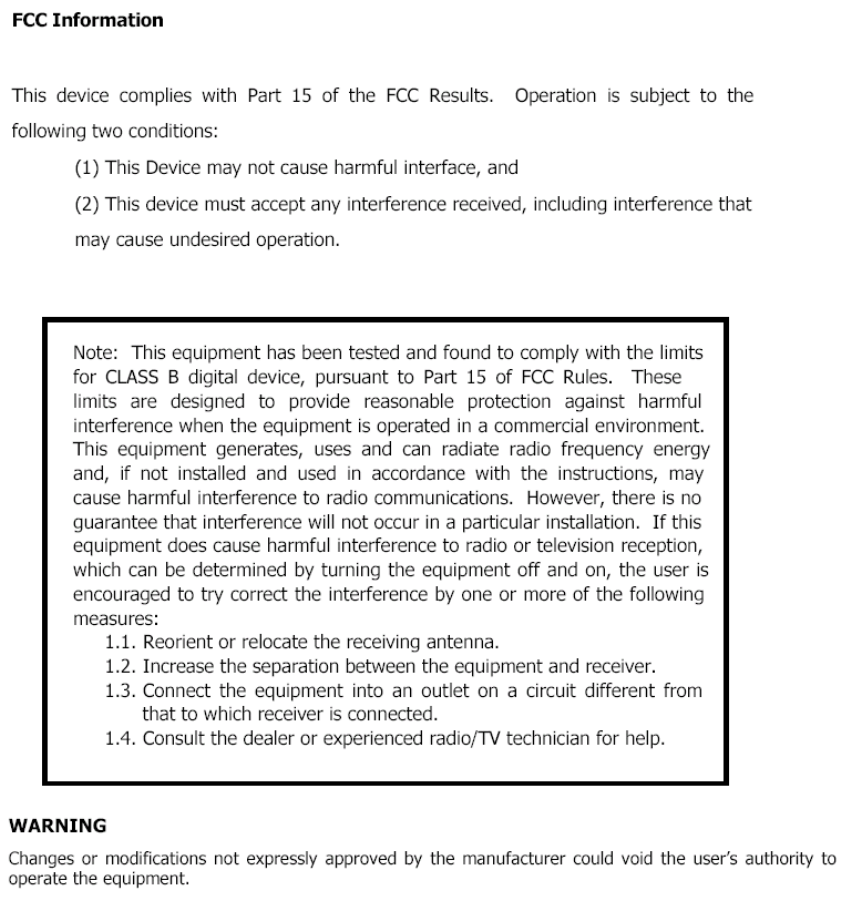DVICO FUSIONMPEGII MPEG1/MPEG2/VCD/SVCD Encoder User Manual FusionMPEG2ManualEng
DVICO Inc. MPEG1/MPEG2/VCD/SVCD Encoder FusionMPEG2ManualEng
DVICO >
User Manual
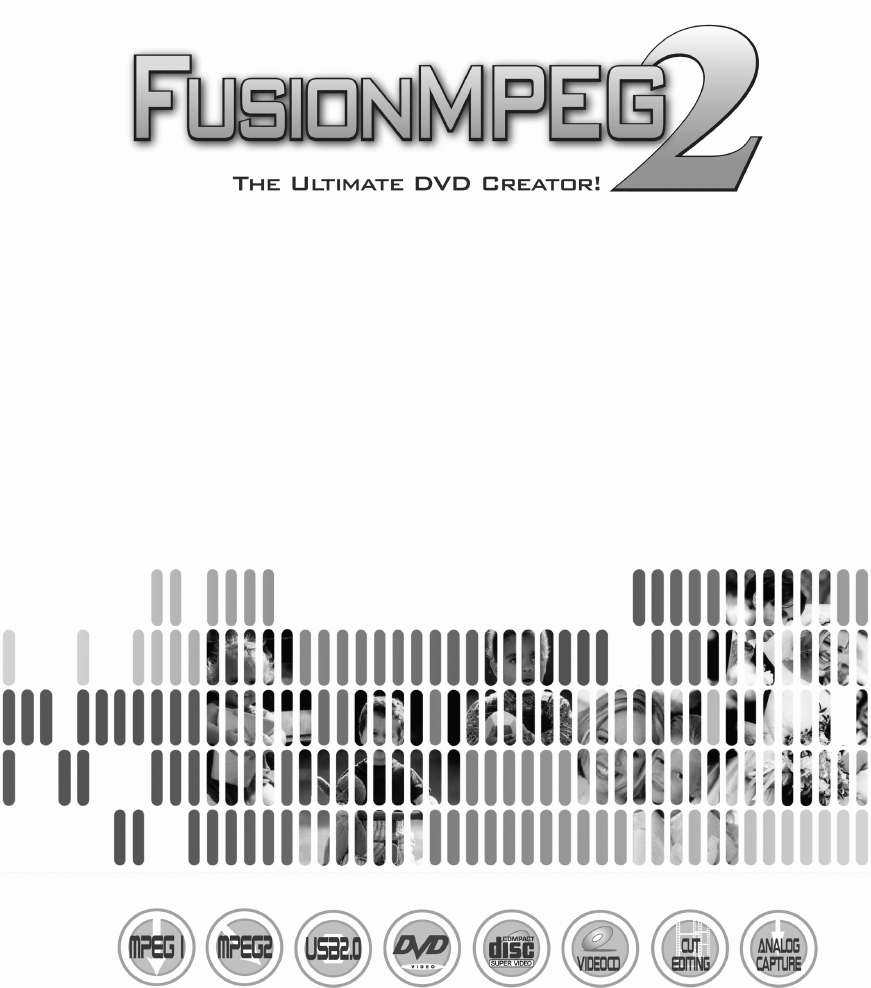
1.
Getting started
2. Software installation
3. Hardware installation
4. Using FusionMPEG2 Application
5. Using Ulead Videostudio 7 SE DVD
6. Appendix
2
1 GETTING STARTED..............................................................................................3
1.1 FEATURES.....................................................................................................3
1.2 SYSTEM REQUIREMENTS.............................................................................5
1.3 PACKAGE CONTENTS ...................................................................................6
2 SOFTWARE INSTALLATION................................................................................7
2.1 INSTALLING APPLICATION ............................................................................7
2.2 Driver installation under Windows 98SE/ME....................................................15
2.3 Driver installation under Windows 2000 Professional .......................................17
2.4 Driver installation under Windows XP .............................................................20
3 Hardware Installation............................................................................................23
3.1 About the Hardware ......................................................................................23
3.2 Before Installation .........................................................................................24
3.3 Install FusionMPEG2.....................................................................................25
4 USING APPLICATION..........................................................................................26
4.1 GETTING STARTED.....................................................................................26
4.2 SUMMARY OF SCREEN AND FUNCTIONS...................................................27
4.3 Configuration ................................................................................................31
4.4 Record .........................................................................................................38
4.5 Playing Files .................................................................................................40
4.6 SnapShot Capturing ......................................................................................41
4.7 Cut Editing....................................................................................................42
5 Using VideoStudio 7 SE DVD .............................................................................44
5.1 Getting started ..............................................................................................44
5.2 Effect............................................................................................................45
5.3 Overlay.........................................................................................................46
5.4 Title..............................................................................................................47
5.5 Creating disc.................................................................................................50
6 FusionMPEG2 APPENDIX ..................................................................................58
6.1 TROUBLESHOOTING...................................................................................58
6.2 SPECIFICATIONS.........................................................................................60
6.3 CUSTOMER SUPPORT................................................................................61

3
1 GETTING STARTED
1.1 FEATURES
Thanks a lot for purchasing the FusionMPEG2. FusionMPEG2 is the most advanced and
feature-rich MPEG1/MPEG2/VCD/SVCD encoder ever made.
FusionMPEG2 has the following outstanding features:
1. Converts all analogue signals to MPEG1/MPEG2 including audio.
FusionMPEG2 converts all type of analog audio/video signals to MPEG1/MPEG2 digital
stream. Since it has composite video, S-VHS, it accepts all type of signals from VCR/
Camcorder/ DVDP/ LDP. You can adjust the encoding quality from DVD quality to VCD
quality according to the required picture-quality and recording space.
2. DVD creation.
FusionMPEG2 provides DVD compliant stream and supports multiple DVD authoring
software including Ulead VideoStudio 7 SE DVD. This is an industry - first multiple DVD
authoring supports and provides the maximum compatibility across the authoring software.
You can burn the real DVD-R which is really playable in the home DVD player with DVD-R
writer or cDVD (mini-DVD) which can be made by normal CD-R writer.
3. Super easy SVCD/VCD creation.
FusionMPEG2 provides the fastest conversion utility that can converts recorded MPEG files
to VCD or SVCD format. It’s really that fast! You can playback those VCD/SVCD on your
home VCD or DVD player as well as PC.
4. Robust, feature-rich MPEG1/MPEG2 encoder.
FusionMPEG2 supports variable bitrate (VBR) MPEG2 encoding up to 8 Mbps as well as
constant bitrate (CBR). It also supports various bitrate of MPEG1. You can set the encoding
resolution such as 352x240 (NTSC), 352x288(PAL), 352x480(NTSC), 352x576(PAL),
480x480(NTSC), 480x576(PAL), 720x480(NTSC) and 720x576(PAL). Audio- It’s also
adjustable.
5. Incredible Cut-on-the-fly feature.
Got a headache to cut the MPG files? FusionMPEG2 provides industry-first cut-on-the-fly
feature. You can actually mark-in and mark-out the current live recording as well as
recorded files. So you can get the precise clips as much as you need. Cutting speed? It’s as
fast as copying files.
6. Limitless recording capability as much as HDD allows.
Since FusionMPEG2 makes indexed multiple files automatically, it can record up to limitless
space virtually. Only the HDD space is the limitation. The indexed MPEG files can be
playback as a single file seamlessly.
7. Adjustable recording size of a single file.
You can set the size of single indexed file, which is very useful for CD-R/RW writing. You
can set the size of file by 1 mega bytes unit.
8. Various file playback functions.
FusionMPEG2 provides the various file playback functions just like live TV mode. That is,

4
pause/ instant replay/ time-shifting by scroll bar/ fast-forward/ fast-rewind. It also has
multiple files playback mode as well as repeat mode.
9. Intuitive user interface.
FusionMPEG2 provides the simple and intuitive user interface, which includes the resizable
video screen, the time-shifting scroll bar and configuration windows.
10. Pause the recording / live broadcasting.
You can pause the recording or live broadcasting with FusionMPEG2, and playback at that
position after your urgent work. (Pausing the live broadcasting is only available on the tuner-
enabled version)
11. Fast forward/ rewind functions just like VCR
FusionMPEG2 provides VCR-like FF/REW functions so that you can scan the wanted Video
scenes or skip the unwanted scenes.
12. Runs on most of PC environment.
FusionMPEG2 USB is for the notebook PC or multiple PCs. FusionMPEG2 PCI is for the
desktop PC. FusionMPEG2 runs on most of the Windows environments like Win’XP/ 98SE/
ME/ 2000 Professional.
13. Not Support FusionMPEG2 Capture under Ulead VideoStudio 7 SE
5
1.2 SYSTEM REQUIREMENTS
lCPU : Pentium II/Celeron 500MHz or faster
lBUS : USB 2.0/1.1
lO.S. : Win’98SE/ ME/2000 Professional/XP (Home, Professional)
lMemory : 128MB or above
lH.D.D. : Ultra DMA33 or faster HDD
lVGA : DirectShow(DirectX 6.0) enabled VGA
lSound card : PCI type sound card
lCD-ROM drive for installation
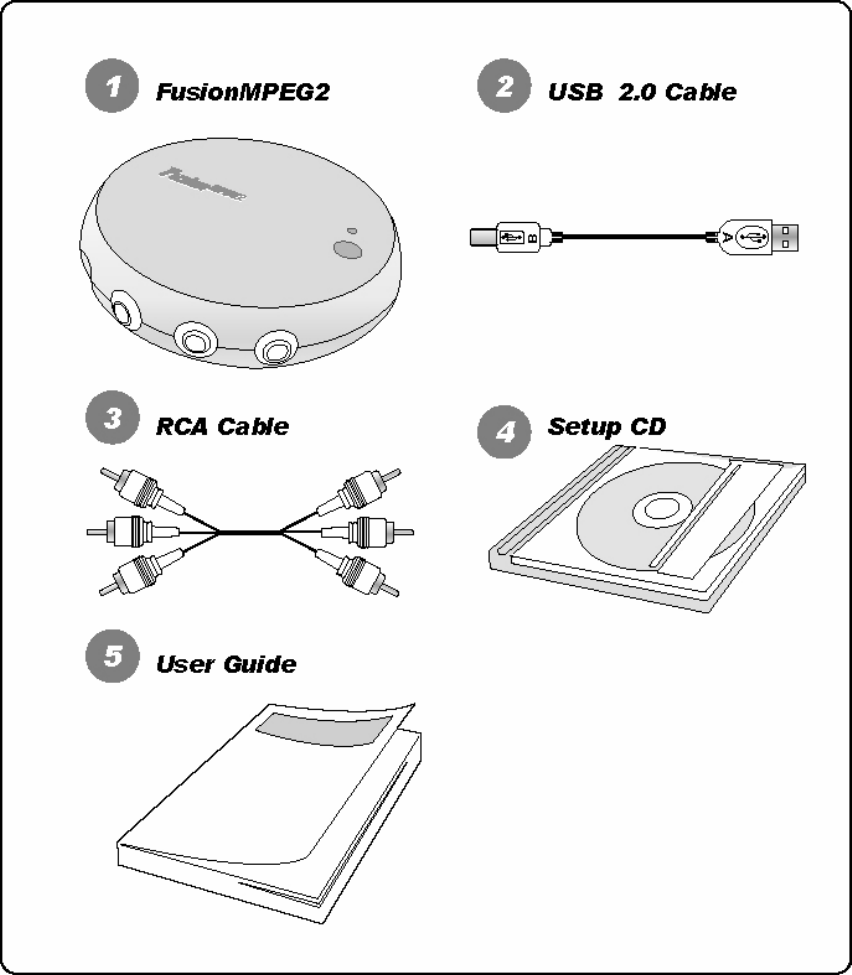
6
1.3 PACKAGE CONTENTS
FusionMPEG2 package contains the following items.
.
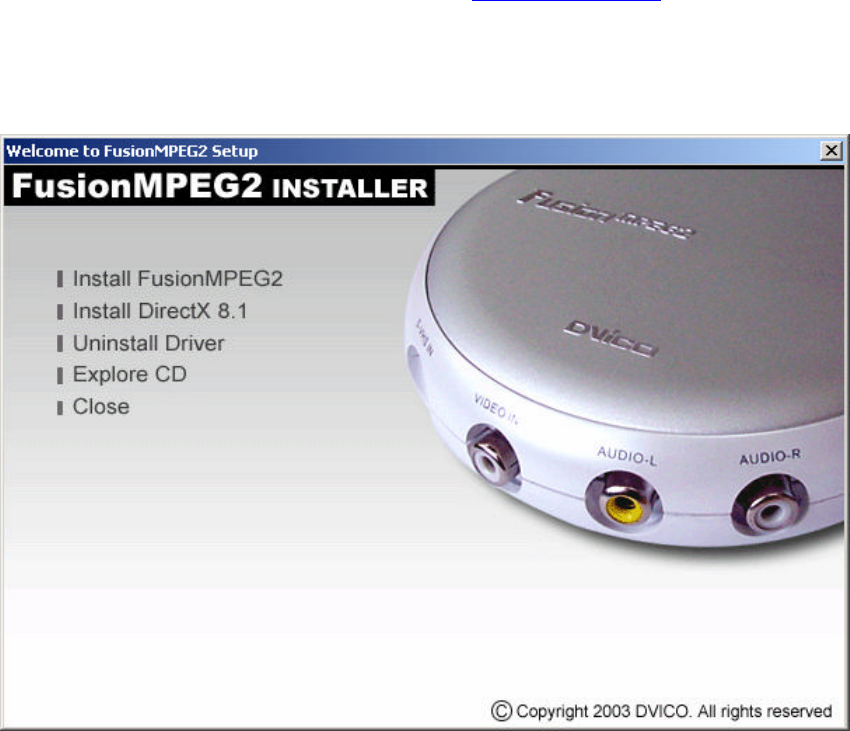
7
2 SOFTWARE INSTALLATION
Software installation of FusionMPEG2 before hardware installation is recommended.
Warning! You should have…
Windows 98/ME/2000/XP installation disc is required to install the FusionMPEG2 software. And
check the latest the FusionMPEG2 setup software at http://www.dvico.com.
2.1 INSTALLING APPLICATION
Insert Fusion MPEG2 Installation CD into the CD-ROM drive. Execute the ‘INSTALL.EXE’ at
CD-ROM drive. The below screen should appear.
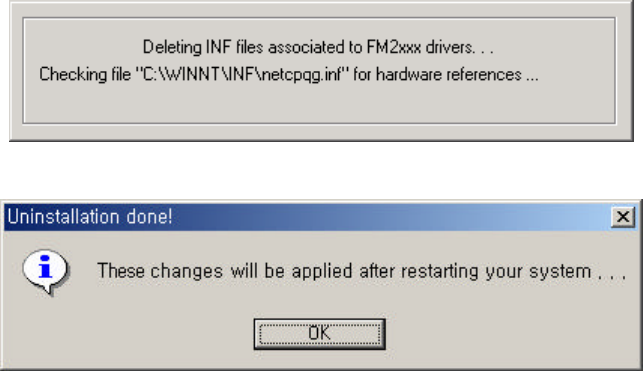
8
2.1.1 Uninstall Drivers
1) When you select Uninstall Driver in the menu on the FusionMPEG2 INSTALLER
program, it will remove all the old drivers previously installed.
2) When all the drives are removed, you will see following message.
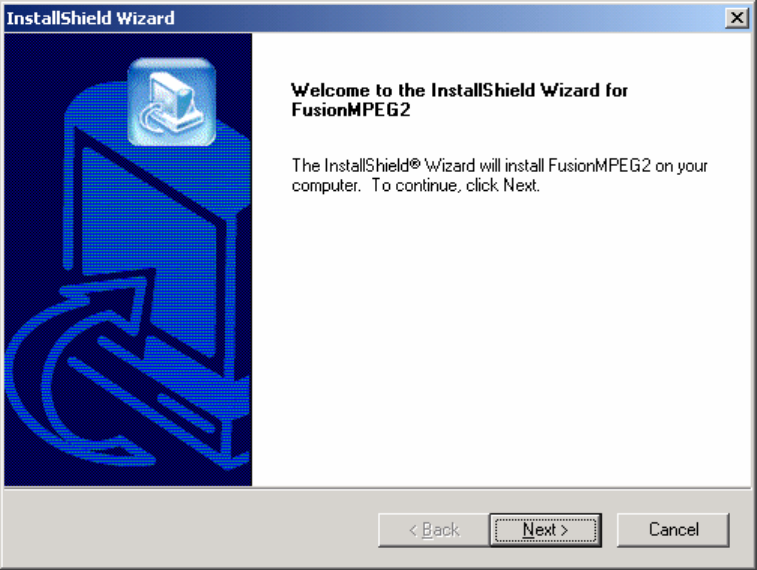
9
2.1.2 Installing FusionMPEG2 Software
Important: Installation on Windows 2000 Professional or Windows XP
Before you install FusionMPEG2 software, be sure that you logged on as an account with
Administrator privileges.
1) Select “Install FusionMPEG2”.
2) At the FusionMPEG2 Installation dialog opens, click on the “Next>” button.
3) Click on ‘Next’. You should be asked the FusionMPEG2 application setup directory.
You can skip it to install it to the default directory. To install to different folder, click
‘Browse’ and select another folder.
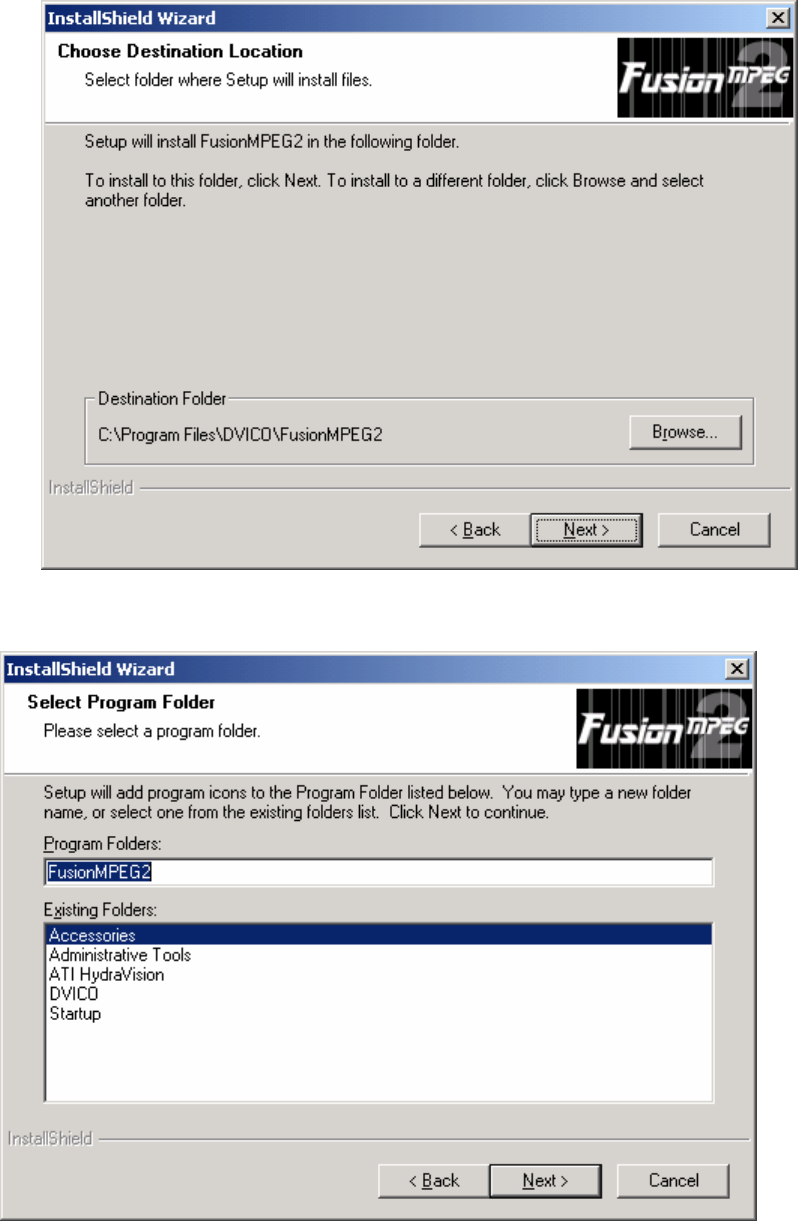
10
4) Program folder selection dialogue box will appear. The default name is ‘FusionMPEG2’
and you can select another by typing another name.
5) The “Setup status” window will appear.
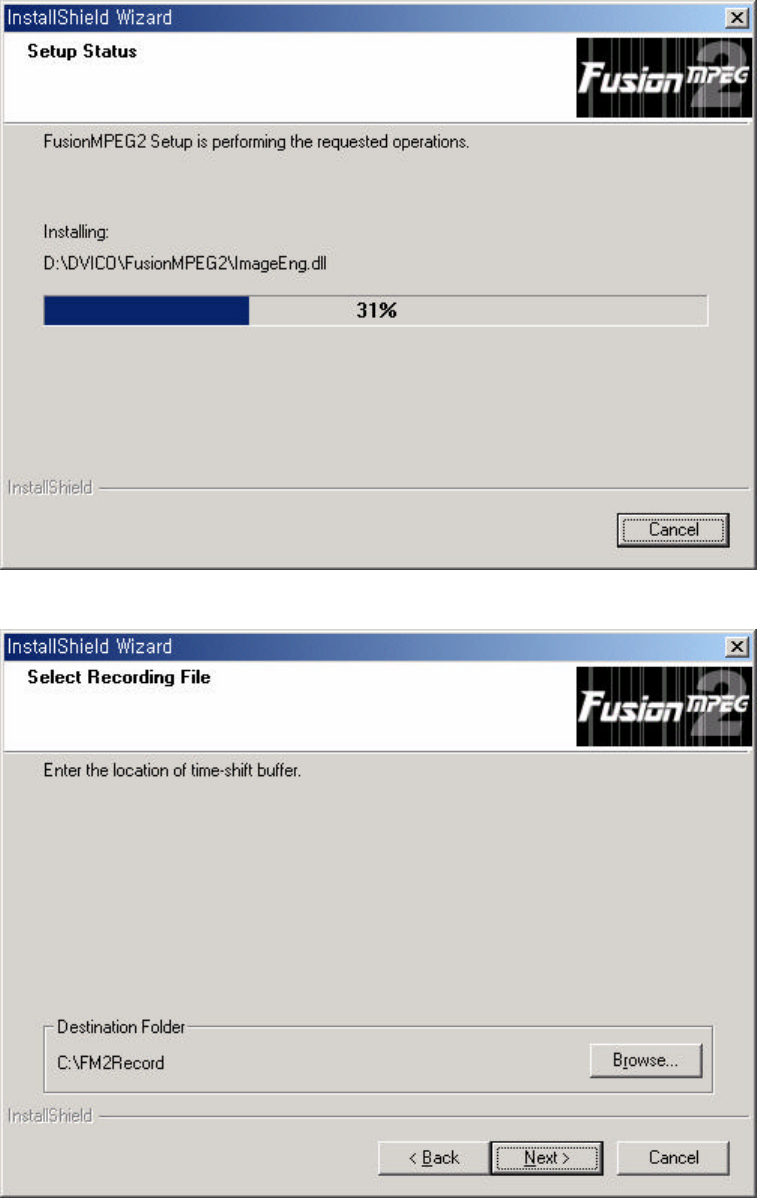
11
6) Select recording File directory.
7) Select Video Format
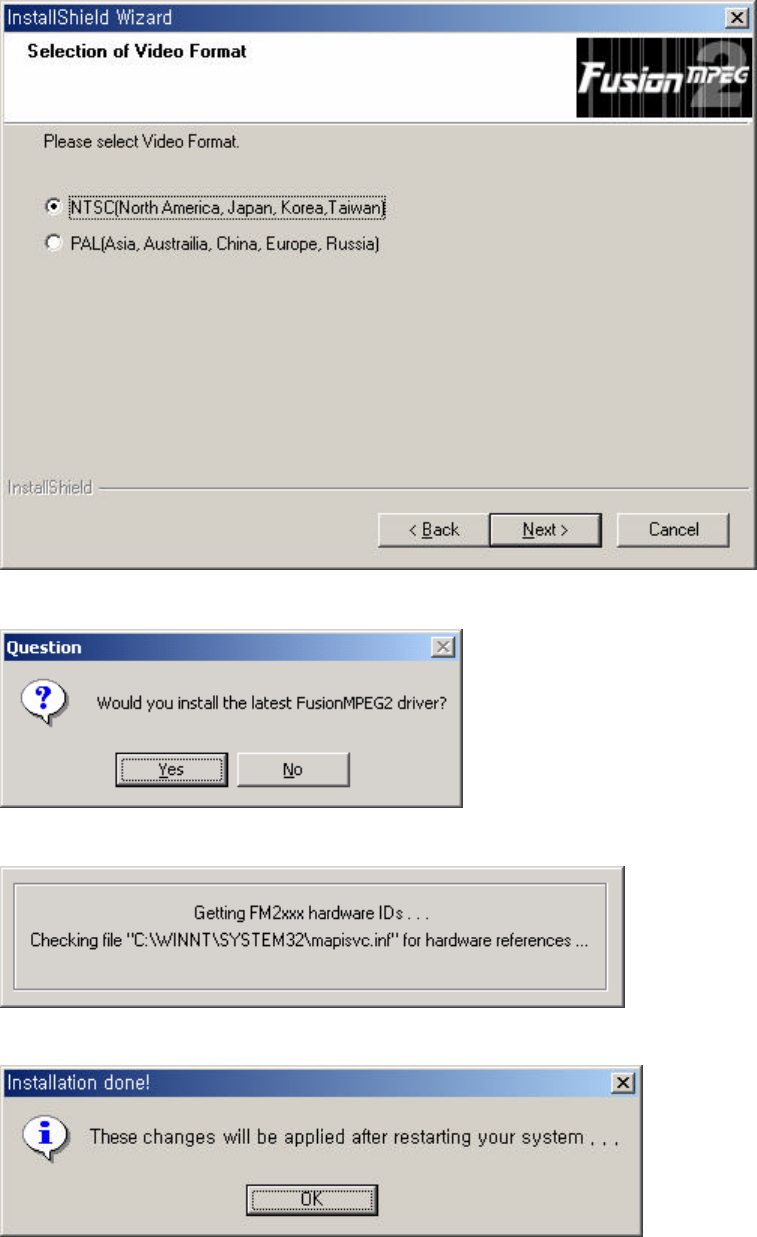
12
8) Press Y to install latest drivers
9) You will see the progress window.
10) Following message indicates the completion of the setup
11) Press “Yes” for the digital signature message
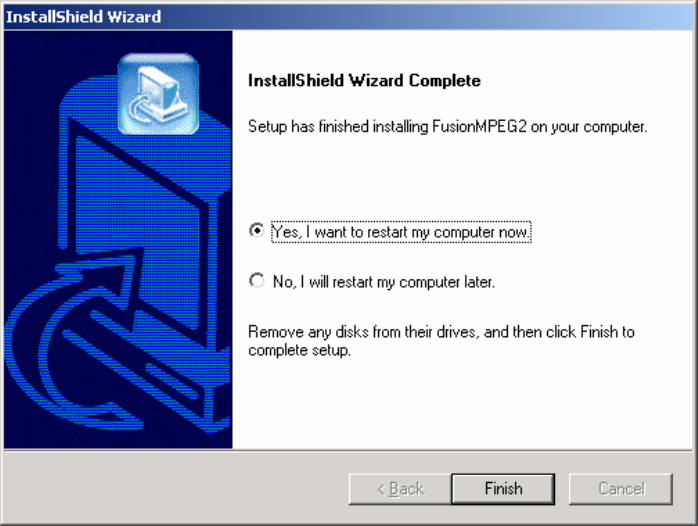
13
12) By clicking the Finish button, the software installation is done.
13) After installation of hardware, all the setup will be done.
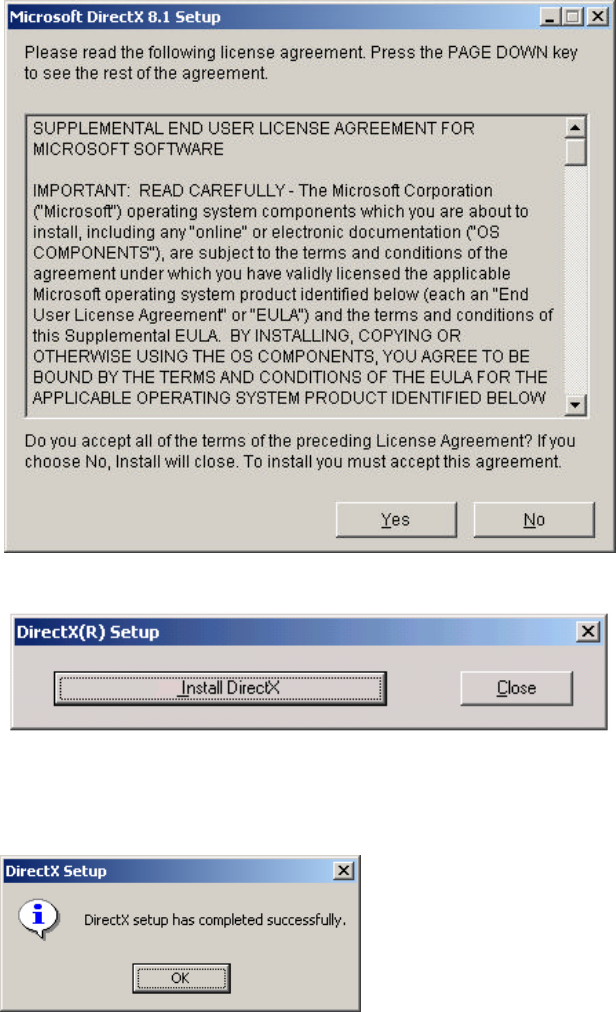
14
2.1.3 Installing Microsoft DirectX 8.1
Important! Installing on Windows 2000 Professional or Windows XP
Before you install FusionMPEG2 software, be sure that you logged on as an account with
Administrator privileges. You can check the version of DirectX by typing “dxdiag” on the
command line which appears with menu selection “start->run”
If you have DirectX8.1 or later already, you do not need to install DirectX8.1 again.
1) Run ‘Install.exe’ and then select “Install Direct8.1X”.
2) Read the License Agreement carefully, and then click on “Yes” if you agree.
3) To start installing of DirectX, click on “Install DirectX”.
Tip If there is a DirectX already installed in the system, a different window will show up
instead of the one above.
4) Click on “OK” to restart system and complete installation of the DirectX.

15
2.2 Driver installation under Windows 98SE/ME
2.2.1 Installing the Windows 98SE/ME driver
1) Insert the FusionMPEG2 board into the PCI local bus slot. When Windows ME starts,
the Add New Hardware Wizard will pop up automatically.
2) Found New Hardware window will pop and ‘FusionMPEG2, USB WDM Encoder’
driver will be installed automatically.
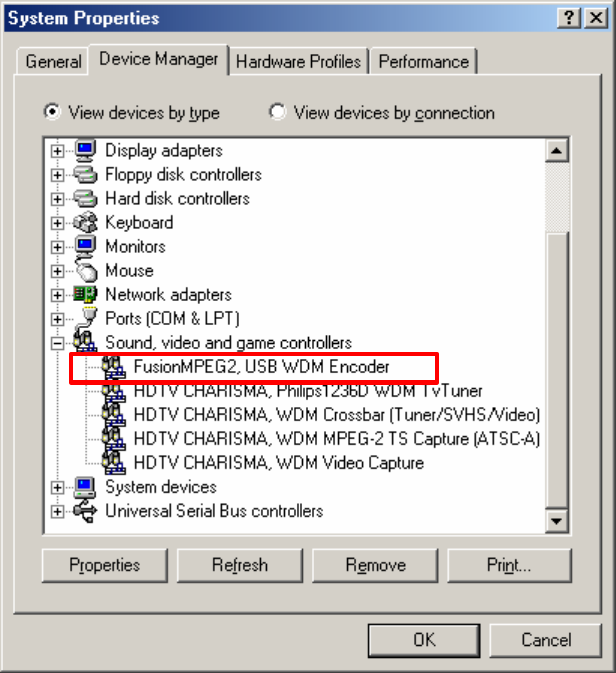
16
2.2.2 Checking Windows 98SE/ME driver
If driver are found in the device manager, the Windows ME driver is installed properly.
Otherwise, you must reinstall the driver.
Right click the “My Computer” icon and select “properties” from the popup menu. Check whether
you see new device starting with “FusionMPEG2, USB WMD Encoder” under the “Sound video
and game controllers”.
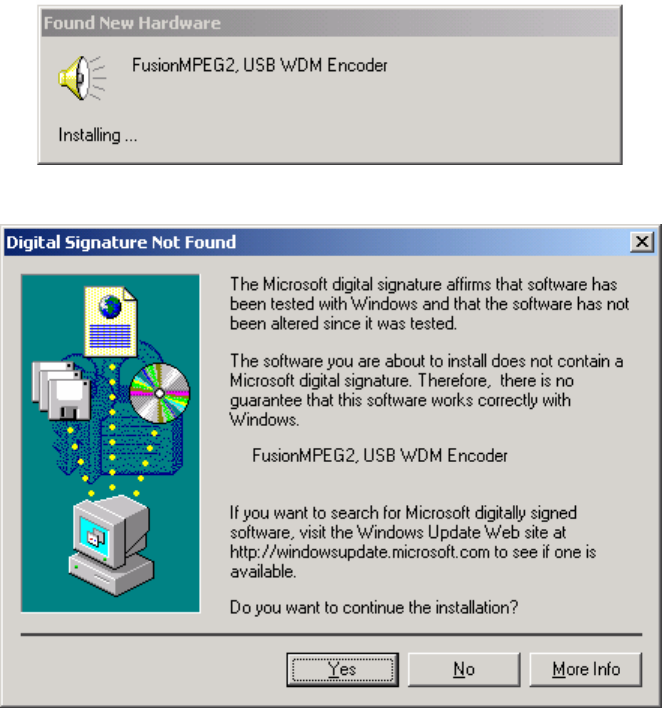
17
2.3 Driver installation under Windows 2000 Professional
2.3.1 Installing Windows 2000 driver
1) Connect the FusionMPEG2 board with USB cable. When Windows 2000 starts, the
Add New Hardware Wizard will pop up automatically.
2) When the Digital Signature Not Found window appears, Click on “Yes”.
3) After the files are copied, Click “Finish”. The ‘FusionMPEG2, USB WDM Encoder’
driver is properly installed.
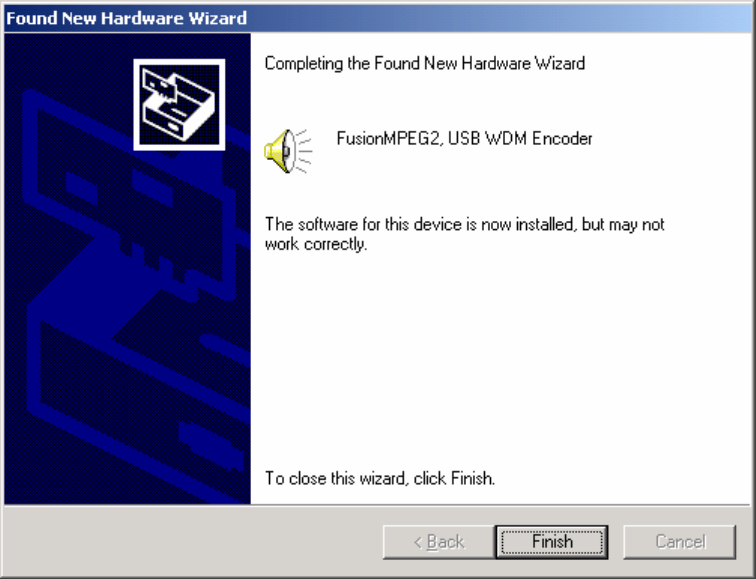
18
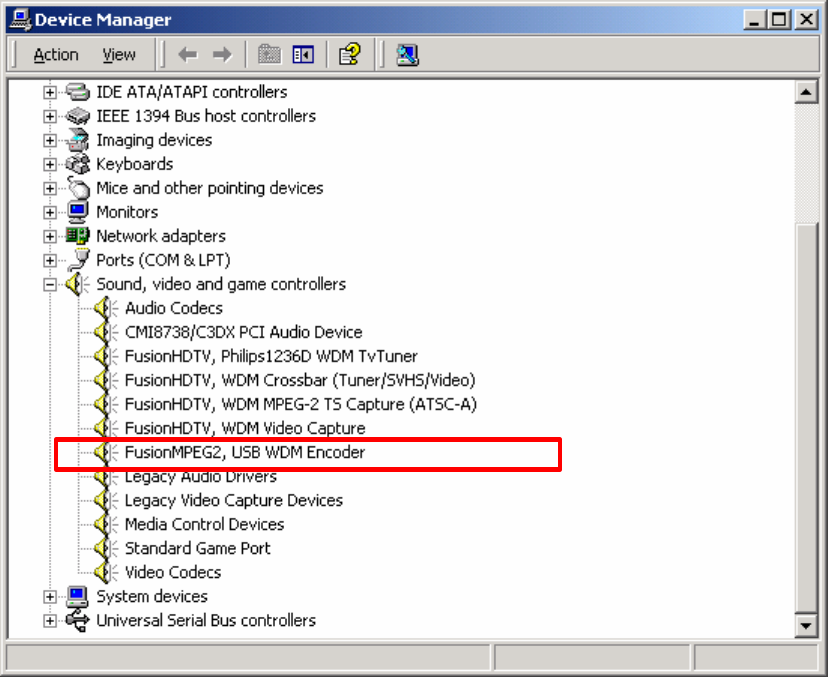
19
2.3.2 Checking the Windows 2000 driver
If driver are found in the device manager, the Windows 2000 driver is installed properly.
Otherwise, you must reinstall the driver.
Right click the "My Computer" icon and select "properties" from the popup menu. Check
whether you see new device starting with "FusionMPEG2, USB WMD Encoder" under the
"Sound video and game controllers"..
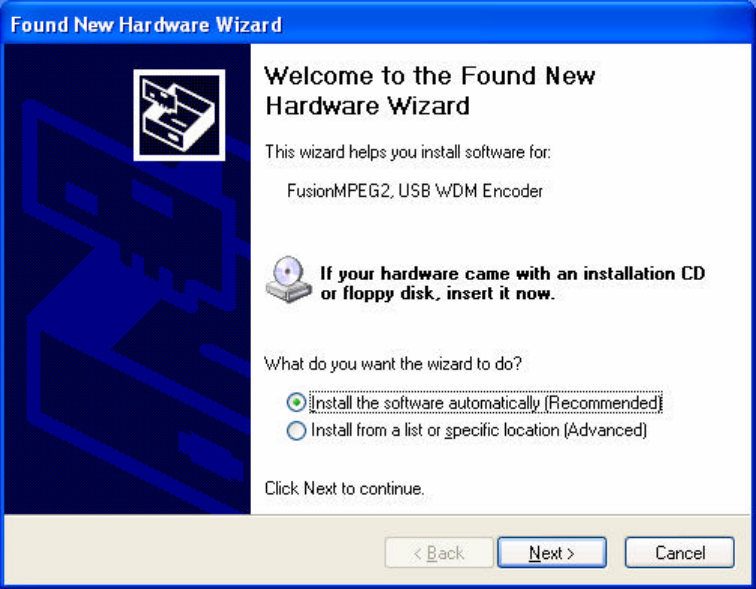
20
2.4 Driver installation under Windows XP
2.4.1 Installing Windows XP drivers
1) When the “Add New Hardware Wizard window” appears, select “Install the software
automatically (Recommended)” and then click “Next”.
2) When the “FusionMPEG2, USB WDM Encoder” window appears, Click “Continue
Anyway”.
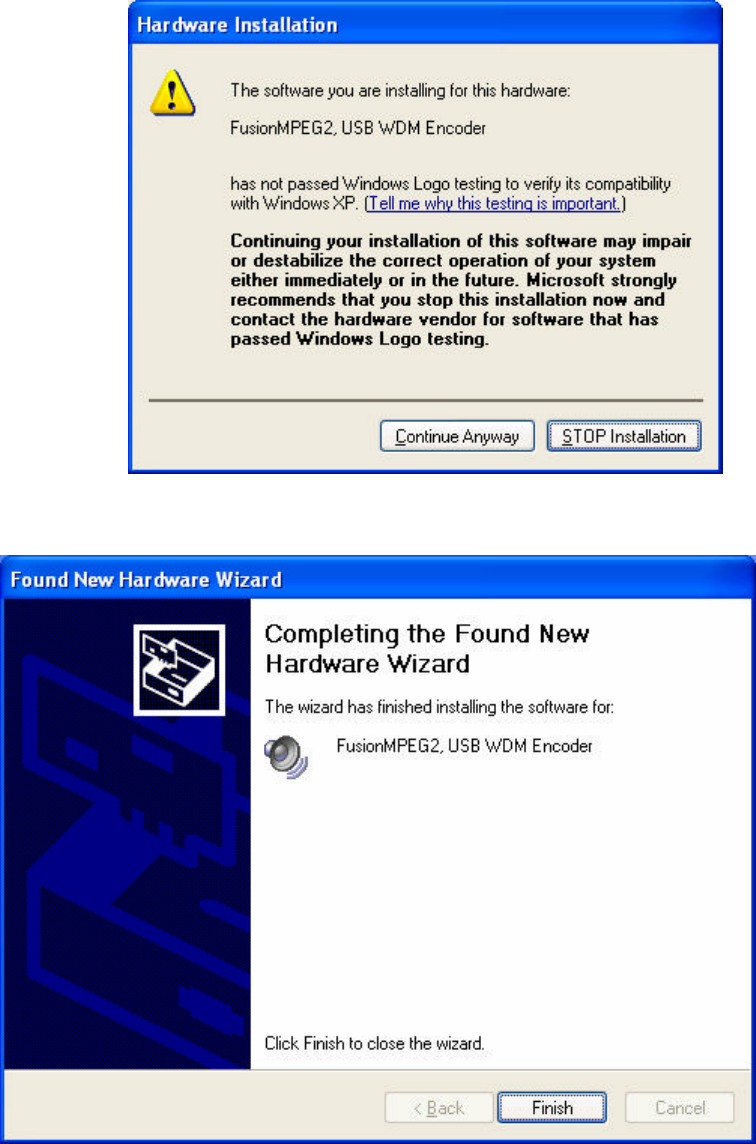
21
3) After the files are copied, Click “Finish” if the FusionMPEG2, USB WDM Encoder’
driver is properly installed.
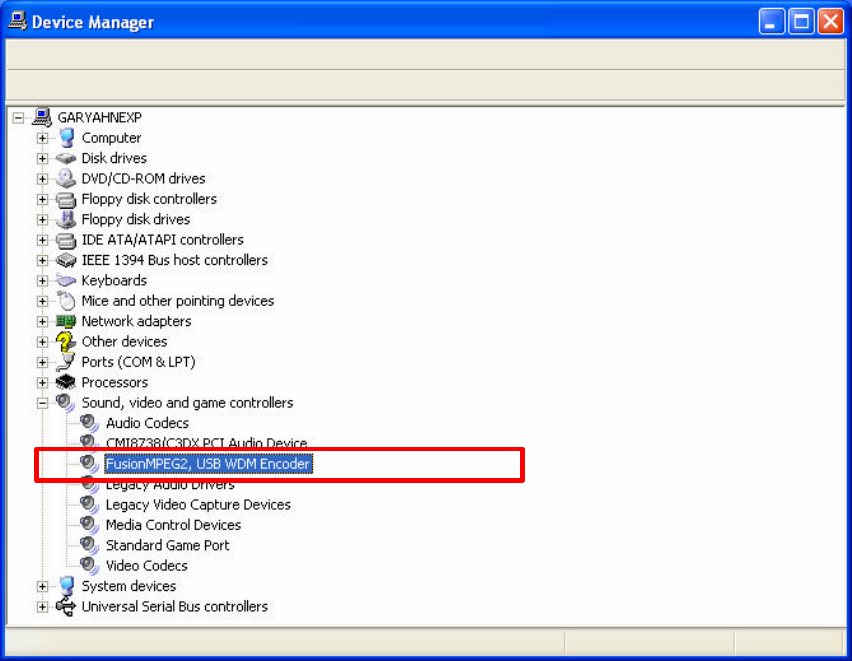
22
2.4.2 Checking the Windows XP driver
If driver are found in the device manager, the Windows XP driver is installed properly. Otherwise,
you must reinstall the driver.
Right click the "My Computer" icon and select "properties" from the popup menu. Check
whether you see new device starting with "FusionMPEG2, USB WMD Encoder" under the
"Sound video and game controllers"..
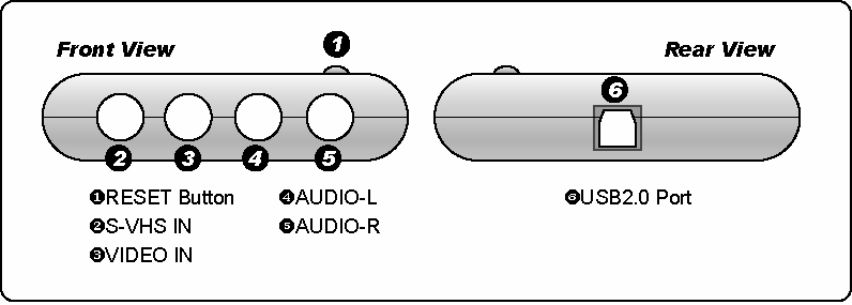
23
3 Hardware Installation
3.1 About the Hardware
RESET Resets the internal hardware of the FusionMPEG2 and USB controller.
S-VHS INPUT
Accepts S-VHS signal from VCR/ Camcorder/ DVDP/ LDP
AUDIO/VIDEO INPUT
Accepts composite video and audio signal from analogue sources.
24
3.2 Before Installation
Warning :
1) Before installing the board, the system’s power should be turned off. Installing the
Board when the system’s power is “ON,” will damage the system or the Board.
. 2) * Note : It may cause malfunction due to shortage of power from USB depending on
various PC
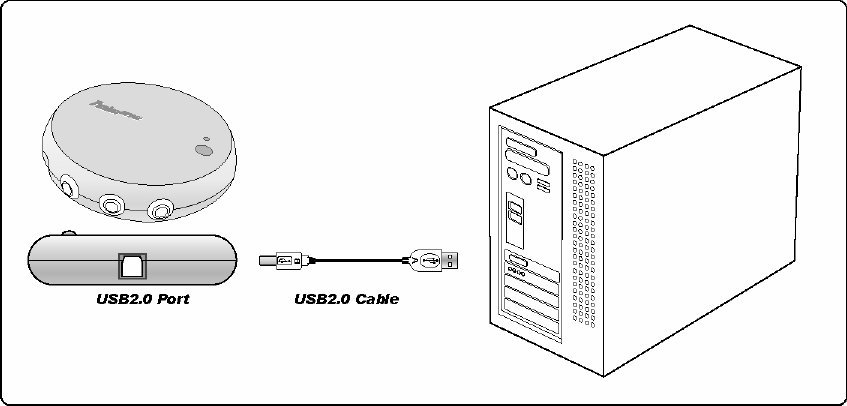
25
3.3 Install FusionMPEG2
Connect the USB cable to the PC USB port and FusionMPEG2. Turn on the PC
.
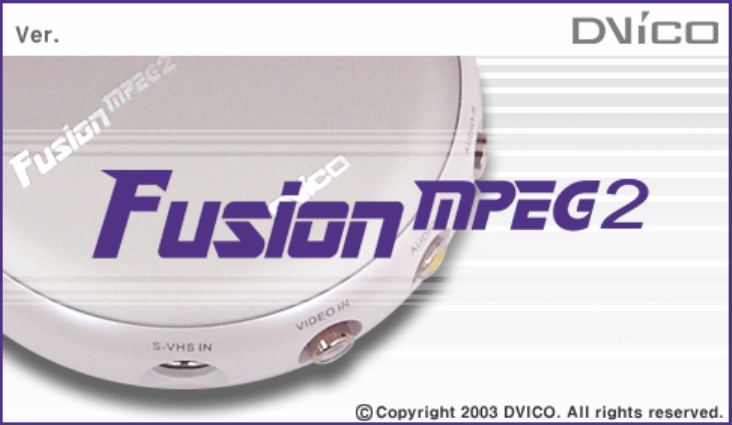
26
4 USING APPLICATION
4.1 GETTING STARTED
Please confirm the power LED is ON in case of FusionMPEG2. Click on ‘Start’ -> ‘Program’ ->
‘Dvico’ -> ‘FusionMPEG2’ to start the FusionMPEG2 application.
The splash screen should appear. After a while, main control panel and display screen should
appear.
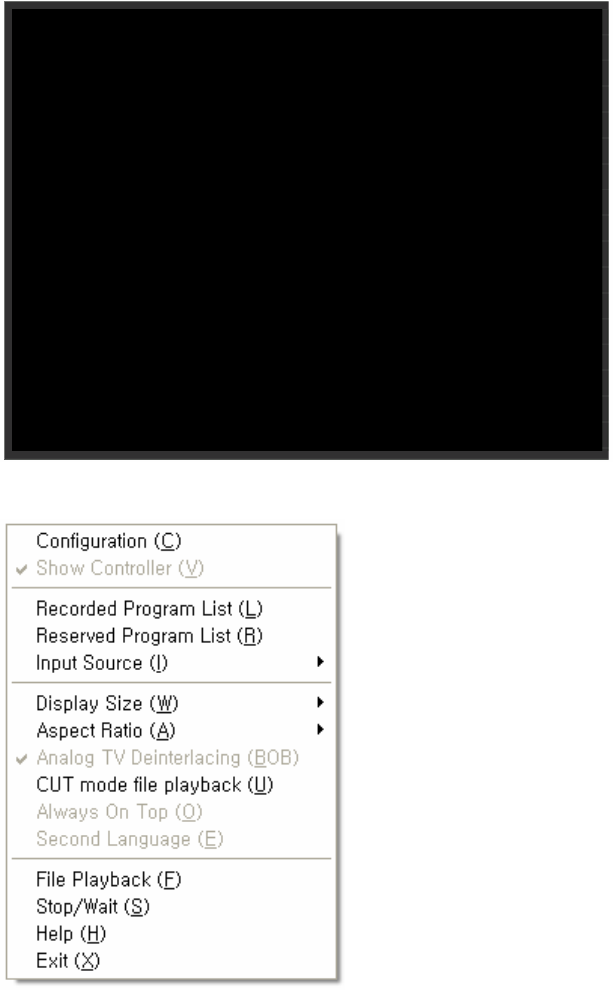
27
4.2 SUMMARY OF SCREEN AND FUNCTIONS
FusionMPEG2 software consists of display screen and control panel.
4.2.1 Display Window
Display window will be set to 640x480 initially. You can move it by clicking the upper boundary
of the display window and drag-and-dropping it. You can resize of the window by drag-and-
dropping the boundaries.
To switch to full screen mode, double click on display window.
If you click right on the video window, a popup menu will appear.
28
• Configuration: Refer to 4.3: Configuration
• Show Controller: Show/Hide Fusion MPEG2’s controller.
• Recorded Program List: Shows recorded list of EPG.
• Reserved Program List: Shows reserved list of EPG.
• Input Source: Change input source.
• Display Size: Resize display.
• Aspect Ratio: Adjust display ratio.
• CUT mode file playback: Change cut edit playback mode.
• Always On Top: Shows Fusion MPEG2 application always on top.
• File Playback: Play input signal(or file).
• Stop/Wait: Change pause.
• Help: Shows Help information.
• Exit: Quit Fusion MPEG2.

29
4.2.2 Controller
This indicates Control Buttons.
1) Exit button
2) Minimize
3) Maximize button
4) Configuration button
5) Help button
6) Reserve REC button: is used to Reservation record.
7) LiveTV button: Changes to live input (SVHS/ Composite) mode.
8) Input button: is used to select input signal.
9) Time: Total elapsed time played.
10) Channel/Input button: Select the current input source (SVHS/ Composite)
11) Channel UP/DOWN button:This button is disabled in FusionMPEG2
12) Volume: Shows and controls the current volume level. Use the mouse or keyboard
up/down button to change the volume level.
13) Mute button: Mute ON/OFF.
14) Open file button: Is used to open recorded files.
15) Snapshot button: Is used for still image capture.
16) Video status
17) Audio status
18) Playback button: Is used to play an input signal (or file).
19) Pause button: Is used to pause playing or replay.
20) Start button: Is used to go to the first scene.
21) End button: Is used to go to the end of a scene.
22) Review button: Is used to search backward.
23) FF button: Is used to search forward.
1 2 3 4 5
6
7
8
9 10
11
12
13
16
17
14
15
31
27
28
29
30
19
20
22
18
21
23
24
25
26
30
24) Stop button
Tip
You can press stop when recording if you want to record the content without
viewing.
25) Instant Replay button: goes 10 sec backward by default. You can configure the instant
replay time in the configuration menu.
26) Record button
27) Cut Edit button: Is used to edit a recorded file.
28) Mark in button: Mark in the start point where the cut starts.
29) Mark out button: Mark in the end point where the cut ends.
30) Time moving slider: Shows location currently playing. If you drag it with the mouse, you
can move anywhere in the white line.
31) Time moving Bar: Is used to drag the slider bar.
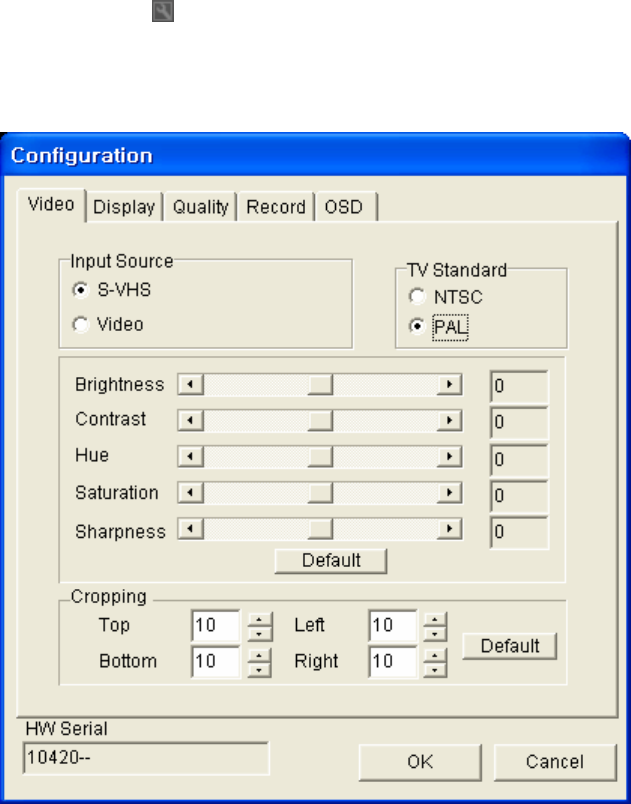
31
4.3 Configuration
Configuration: ( ), you can Configure many parameters.
4.3.1 Video
Video settings tab.
Input Source : Selects between multiple external video sources.
You can select antenna input S-VHS or Video
Cropping : flickering lines near the top or bottom of the picture can be removed with cropping
function
Video tap is possible with adjust Brightness/contrast/Hue/Saturation/Shatpness.
Click on the " OK", and you can play adjusted display..
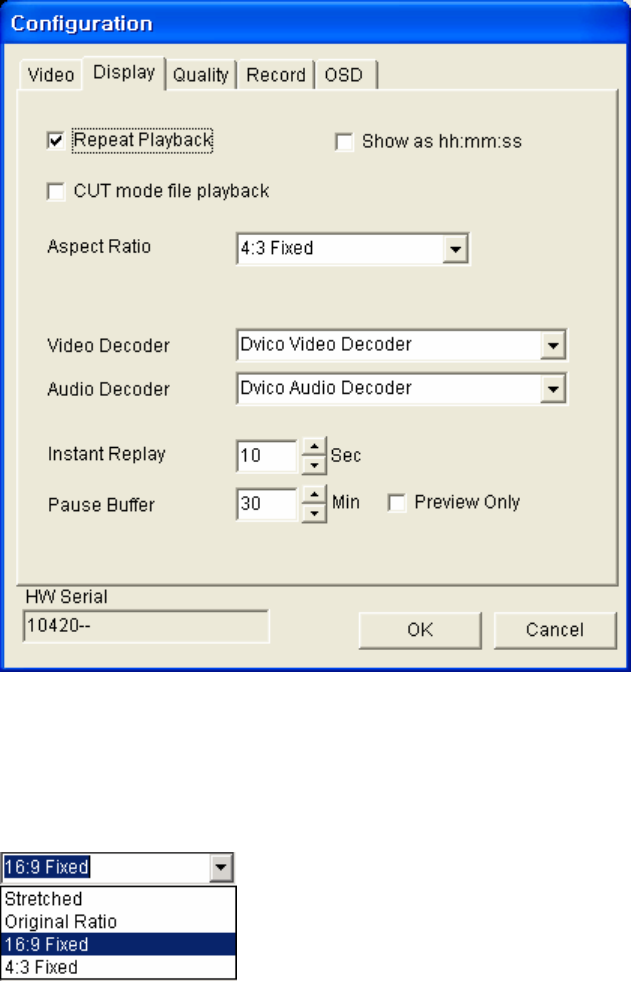
32
4.3.2 Display
You can select the display options (like AV decoders/ aspect ratio) on ‘Display’ tab.
Repeat playback: It will play the file endlessly if checked.
Show as hh:mm:ss: Shows time from 00:00:00.
CUT mode file playback
Aspect Ratio : Is used to fIx screen ratio..
Video Decoder: Is used to select a video decoder among the various decoders. You can select
one of those decoders. (You should install the appropriate software to use another decoder
except Dvico’s own decoder)
< Dvico MPEG2 Video Decoder >
<InterVideo MPEG2 Video Decoder (WinDVD)>
<CyberLink MPEG2 Video Decoder (PowerDVD)>
33
Audio Decoder: Is used to select audio decoder among the various audio decoders. You can
select one of those decoders. (You should install the appropriate software to use another
decoder except Dvico’ own decoder)
< Dvico MP2 Audio decoder >
<InterVideo Audio Decoder (WinDVD)>
<CyberLink Audio Decoder (PowerDVD)>
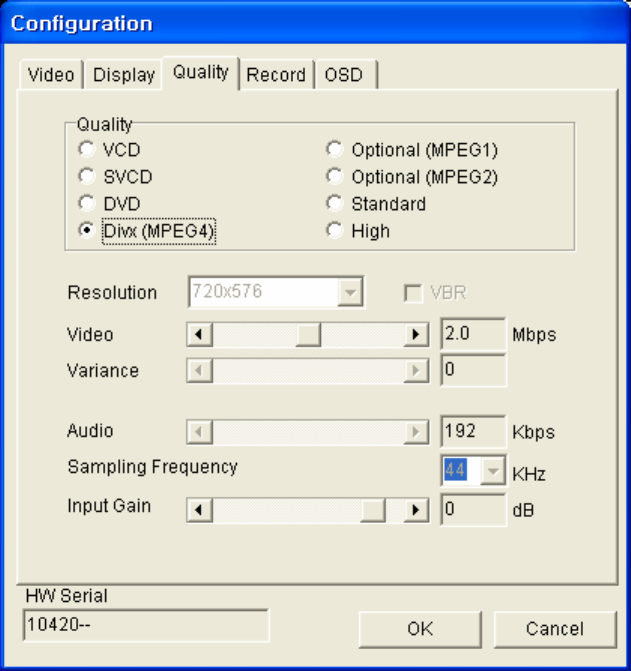
34
4.3.3 Quality
This section indicates Quality settings
You can set the various recording quality here. You can choose the pre-setting bitrates from
drop-down list box. If you want to more specific settings, you can choose the ' Optional' bitrate.
You can also adjust the recording resolutions like full D1 (720x480 NTSC, 720x576 PAL), 66
percent D1 (480x480 NTSC, 480x576 PAL), half D1 (352x480 NTSC, 352x576 PAL) and CIF
(352x240 NTSC, 352x288 PAL).
You can adjust the MPEG1 bitrate from 0.7Mbps ~ 4.0Mbps, if you select the 'Optional
(MPEG1)' bitrate.
You can adjust the MPEG2 bitrate from 2Mbps ~15Mbps (up to 6Mbps in USB 1.1 interface)
and also adjust the VBR, if you select the 'Optional (MPEG2)' bitrate.
You can also adjust the audio encoding bitrate from 192KHz~384KHz, and sampling frequency
like 32/ 44.1/ 48KHz. You can adjust the input audio gain from -78dB to +12dB either. It’s quite
useful if you have abnormal sound-recorded material.

35
Recording Capacity / Time Table
MPEG-2
Quality Bitrate
Res. Space
for 1 Min
Space for
1 Hour Time to 20GB
HDD
Time to
650M CR-R
Standard
5Mbps
720*480
(720*576)
~37MB ~2.3GB ~8.7 hrs
~16 mins
High 8Mbps
720*480
(720*576)
~60MB ~3.6GB ~5.5 hrs
~11 mins
Highest
10Mbps
720*480
(720*576)
~75MB ~4.5GB ~4.4 hrs
~8 mins
SVCD 2.5Mbps
480*480
(480*576)
~19MB ~1.1GB ~17.6 hrs
~40 mins
DVD 5Mbps
720*480
(720*576)
~40MB ~2.1GB ~9.6 hrs
~17 mins
Divx 2Mbps
720*480
(720*576)
~17MB ~1.0GB ~20 hrs
~41 mins
MPEG-1
Quality
Bitrate
Res. Space
for 1 Min
Space for
1 Hour Time to 20GB
HDD Time to
650M CR-R
VCD 1.1Mbps
352*240
(352*288)
~10MB ~650MB ~30 hrs
~1 hr
High 2Mbps 352*240
(352*288)
~15MB ~900MB ~22hrs
~ 43 mins
Tip1 You should choose the VCD/SVCD quality to make the VCD/SVCD, since VCD and
SVCD bitrate is fixed.
Tip2 To make the DVD, you should make sure one thing. You should choose the full
D1 (720x480 or 720x576) resolution regardless of bitrate..
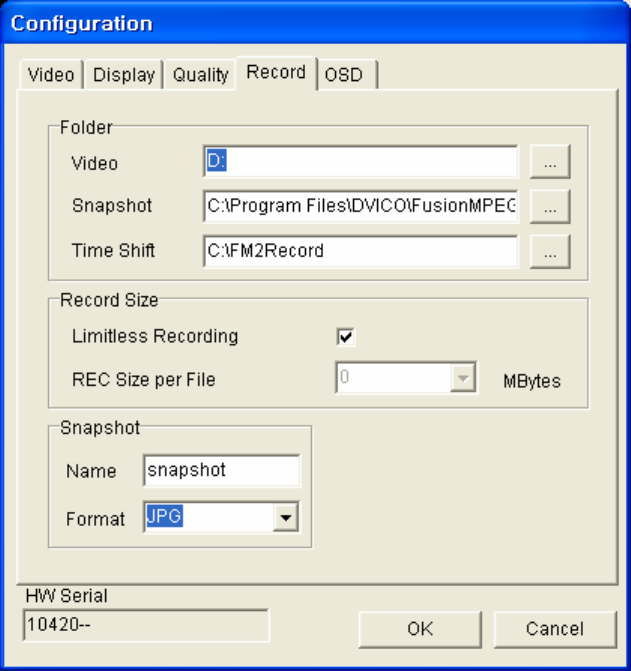
36
4.3.4 Record
Folder – Video : Sets the folder where the video being recorded.
Folder – Snapshot : Sets the folder where the snapshot (still image) being captured
Folder – Timeshift : Sets the folder where the time-shift temporary file resides
Limitless Recording : If the record drive is formatted with NTSF, you are able to record
a file continuously on a hard drive.
REC SIZE per file : Sets maximum file size to be recorded. The program will create a
new file and start recording if the current file exceeds this limit.
Snapshot – Name : Set the name of the snapshot file being saved.
Snapshot – Format : Sets the format of the snapshot (JPG or BMP, PNG, TIF, GIF)
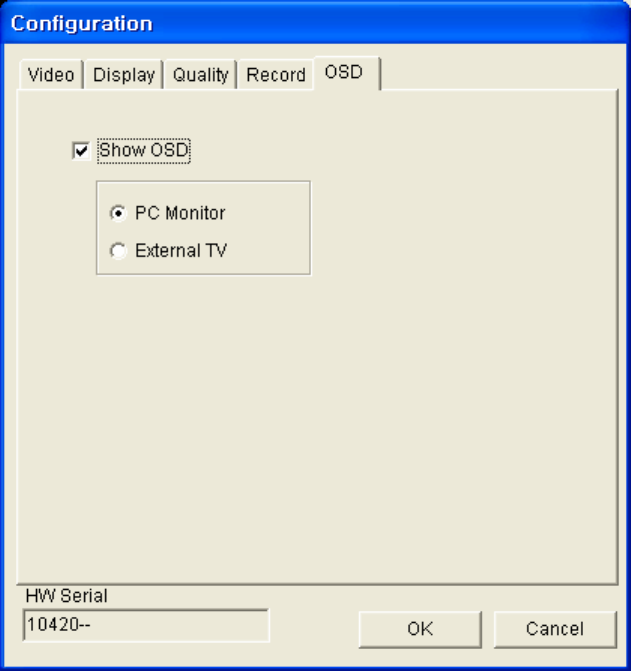
37
4.3.5 OSD
Show OSD: Is used to show channel and volume; on screen display
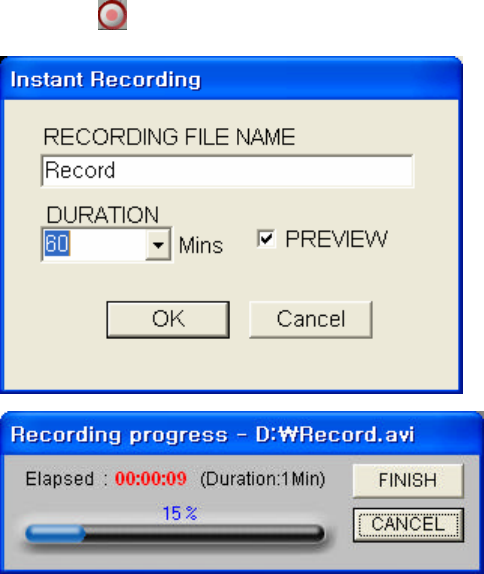
38
4.4 Record
There are two types of recording in the FusionMPEG, they are manual and reserved mode
recording.
4.4.1 Manual Record
Press the (record button) on control panel to record instantly. Press the STOP button or
record button again to stop the recording
If you want to terminate recording, click on the “Finish” button. The files recorded within that
time will be saved.
If you want to cancel recording, click on the “Cancel” button. When you click the cancle button
while recording, you 'll get a message selecting Yes or No
Tip You can use the time-shifting functions as well in recording mode.
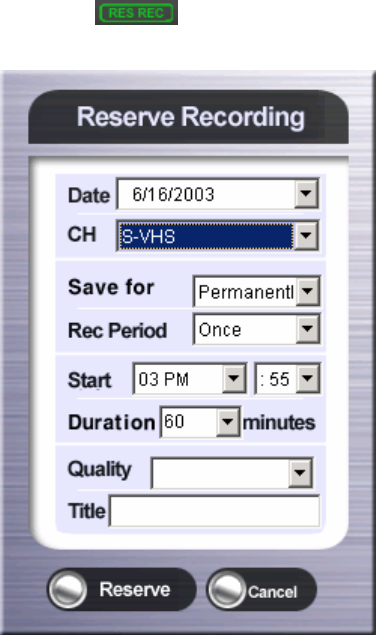
39
4.4.2 Reserve Recording
Press the (reserved recording button) on control panel to reserve the future recording.
You can set the date/ start time / duration/ channel/ quality/ periodical/ name in this menu.
On ‘Date’ section, you can select the date when you want to record.
On ‘CH’ section, you can select the VIDEO or S-VHS port that you want to record.
On ‘Save term’ section, you can select the recorded file saving period. After save period expired,
the file will be purged automatically. The default is ‘Permanent’ which means ‘DO NOT DELETE
THE RECORDED FILE’
On ‘Rec Period” section, you can select the recording cyclic period. It’s very useful record the
some periodically repetitive programs on Video.
On ‘Start’ section, you can select the start time of reserved recording.
On ‘Period’ section, you can select the duration of reserved recording. You can select arbitrary
size as you want.
On ‘Quality’ section, you can choose the recording quality you want.
On ‘Title’ section, you can type the title of your reserved recording.
After done, please click the ‘Reserve’ button, or click ‘Cancel’ button to cancel.

40
4.5 Playing Files
If you click on the 'open file' ( ) button on the controller, you can play a file.
You can also select multiple files for playback
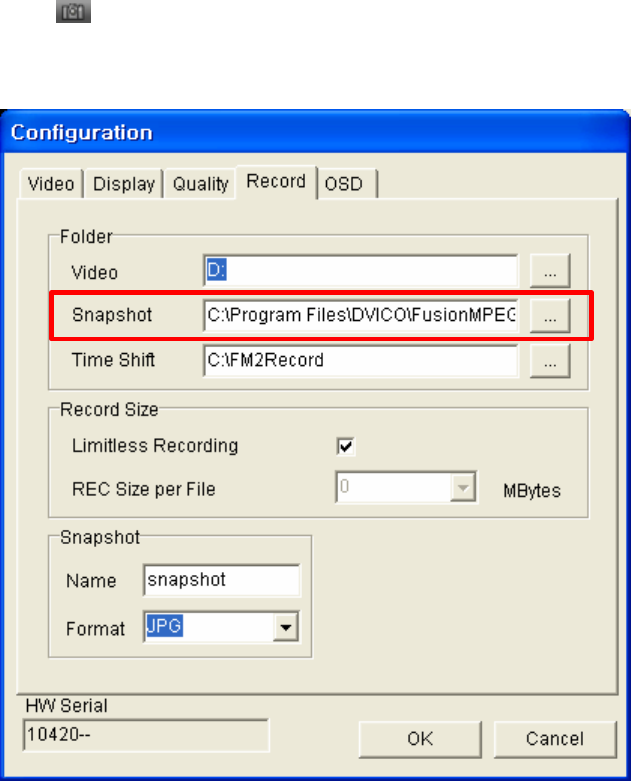
41
4.6 SnapShot Capturing
FusionMPEG2 provides high resolution still screen capture capability in live playback as well as
in file playback mode.
Click the snapshot button for capturing a snapshot of Live while in playback or file
playback mode.
In the Record Tab, you can set the file name and file format.
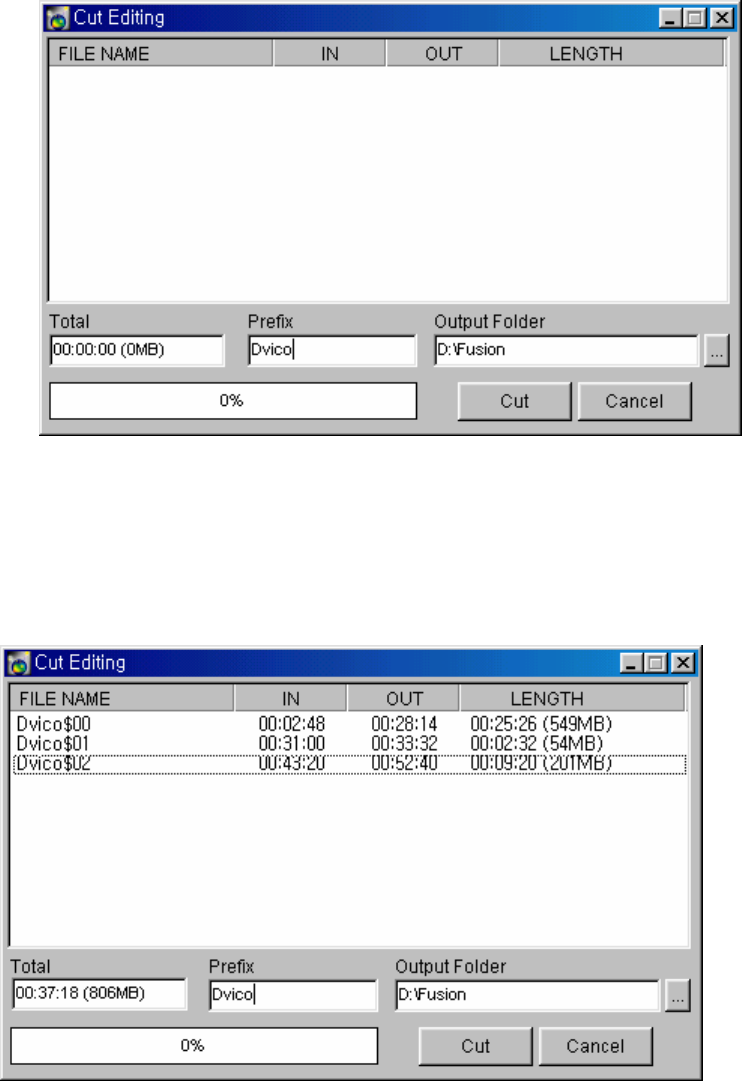
42
4.7 Cut Editing
You can cut the recording files as well as recorded .mpg file with the cut-editing feature of the
FusionMPEG2.
1. The cut-editing window will appear if you hit the ‘Cut’ button. (Mark-in/out button also
brings the cut-editing window)
2. You can set the prefix name on the ‘Prefix’ edit-box to generate the prefix of cut-edited
file name automatically.
3. You can set the output folder by pressing the right-side button of output folder edit-box.
The generated cut-edited files will be saved at that folder.
4. Hit the ‘Mark-In’ button to set the start point and ‘Mark-out’ button to set the end point
of clip. You can proceed with multiple clips with this manner.
5. To change the file name, just click the file name area. The edit-box will appear and you
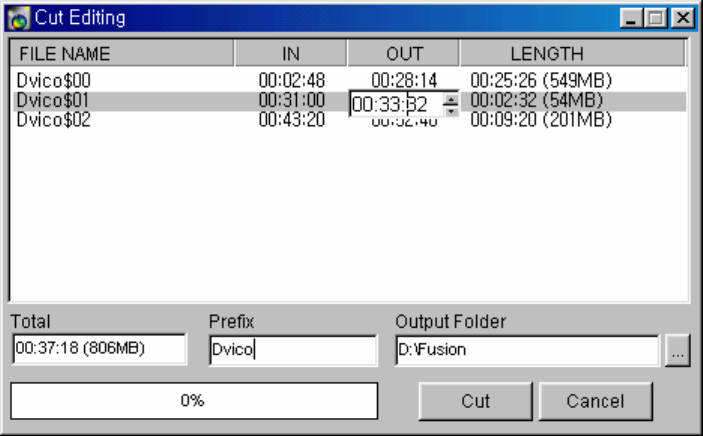
43
can type the filename. To change the IN/OUT position, just click the spot you want to
change. The edit-box and up/down buttons will appear for you to change the position.
To change the hour / minute/ second, click each area you want. Then type the actual
position, or hit the up/down arrow button to adjust.
6. You can delete unwanted clips by hitting the ‘Delete’ key on the keyboard.
7. After all mark-IN/OUT done, hit the ‘Cut’ button to start the cutting.
Cut files will be generated like this: ‘Prefix + $ + number + .tp’ sequence (For example,
like Dvico$00.tp, Dvico$01.tp, Dvico$02.tp) in the output folder.
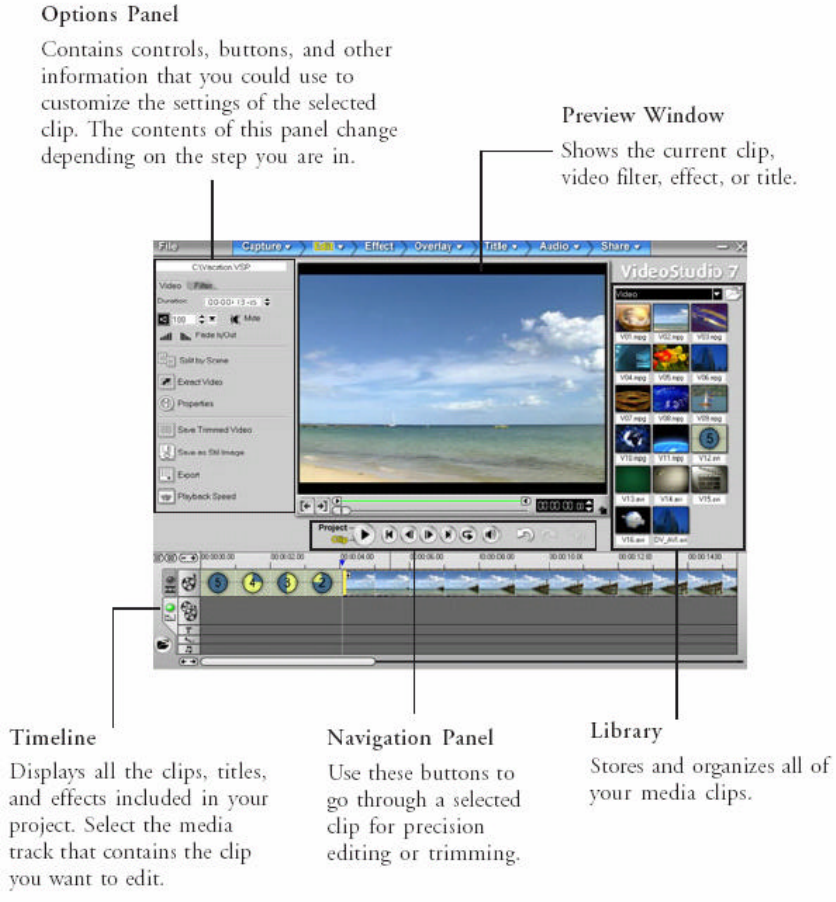
44
5 Using VideoStudio 7 SE DVD
5.1 Getting started
VideoStudio gives you much room to explore your options and experiment by letting you work
with Project files (*.VSP). Since all changes (i.e. cuts, edits, transition effects, etc.) are saved in
the project file, you can freely edit the clips in a project without having to worry about ruining
your source files. A project file is not the finished movie and can only be opened in VideoStudio.
It is also possible to have a number of different projects using the same clips. The actual
process of creating a movie from a project file is performed in the Share Step.
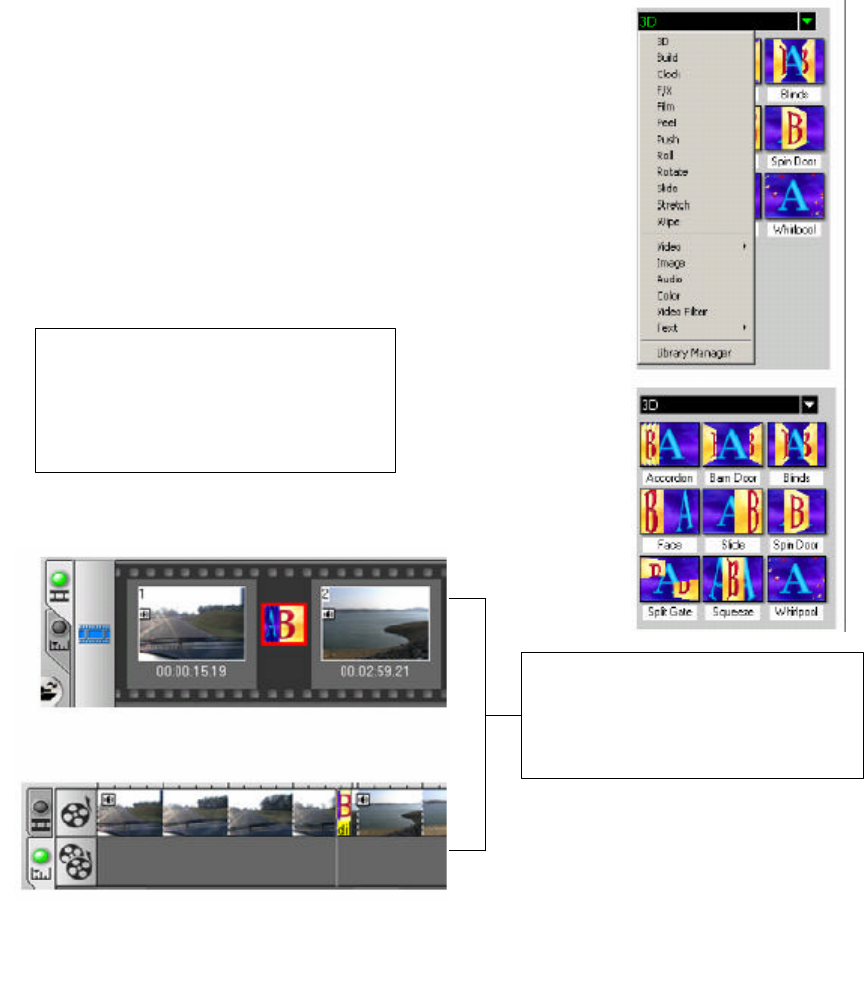
45
5.2 Effect
Transition effects offer creative ways to shift from one scene to the next. They are applied
between clips in the Video Track and their attributes can be modified in the Options Panel to suit
a specific purpose. VideoStudio allows you to mix and match a variety of preset effects while
editing your project. Effective use of this feature can add a
professional touch to your work.
5.2.1 Creating effects
The Library provides a wide range of preset transitions from cross fades to explosions. We will
deal with the details of these effects later. For now, you just need a project with two video clips
in it.
To add a transition:
1. Select a category of effects from the Folder list.
2. Scroll through the effects thumbnails in the Library.
Select and drag an effect to the Timeline, roughly between two
video clips. Drop your effect and it will snap into place. You
can only drag and drop one clip at a time.
Drag and drop transition effects
right onto the tracks in both
Storyboard Mode and Timeline
Mode.
Note: Transitions work the same
way in both the Storyboard Mode
and Timeline Mode. But you may
find it easier to work on transi
tion
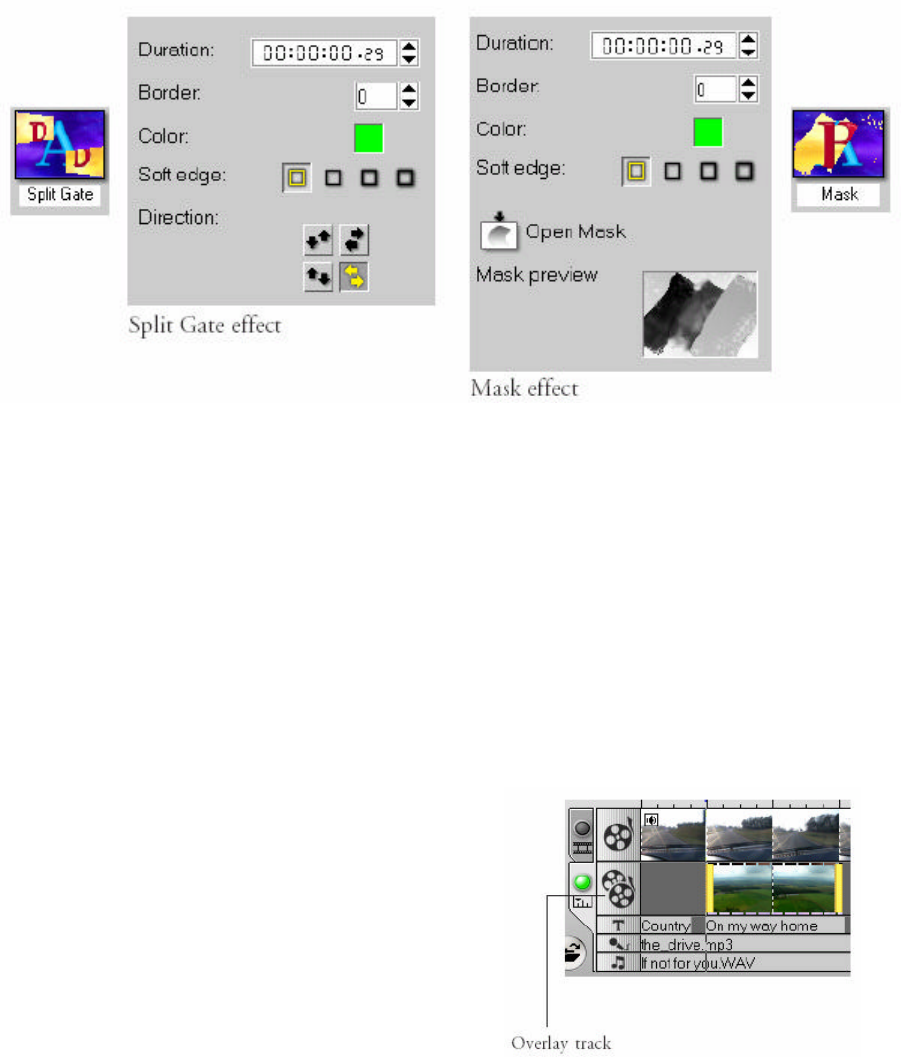
46
5.2.2 Customizing effects
VideoStudio pretty much takes care of all the details to make your transitions smooth and
professional. You can, however, further customize your effects after adding them to your project.
The Options Panel displays the settings of your selected effects so that you can change their
various parameters. This gives you complete control of xactly how your effects will behave in
your movie.
5.3 Overlay
The Overlay Step provides an additional track where you can place videos and images to
enhance introductions and credits. An alphachannel is automatically applied to clips placed in
this track for transparency. By using an animation style such as fade-in and fadeout, you can
interweave two clips, one in the Video Track and another in the Overlay Track, in one timeline.
You can even have three separate clips playing simultaneously by adding a clip in the Title
Track.
Inserting video/image in the Overlay Track
Working in the Overlay Track is similar to working in the Video Track. You can drag and drop
clips and images (color clips are not available in Overlay) to arrange their order. You can also
apply a motion style effect, that controls the way the overlay clip “blends” with the clips in the
Video Track.
To insert a clip to the Overlay Track:
1. Select Video/Image in the Folder list or click Load
video/ Load image to browse and select a file.
Drag and drop the selected clip from the Library to the
Overlay Track in the Timeline.
Or, to insert a video or image file directly into the
Overlay Track, click the Overlay Track and then click
Insert media
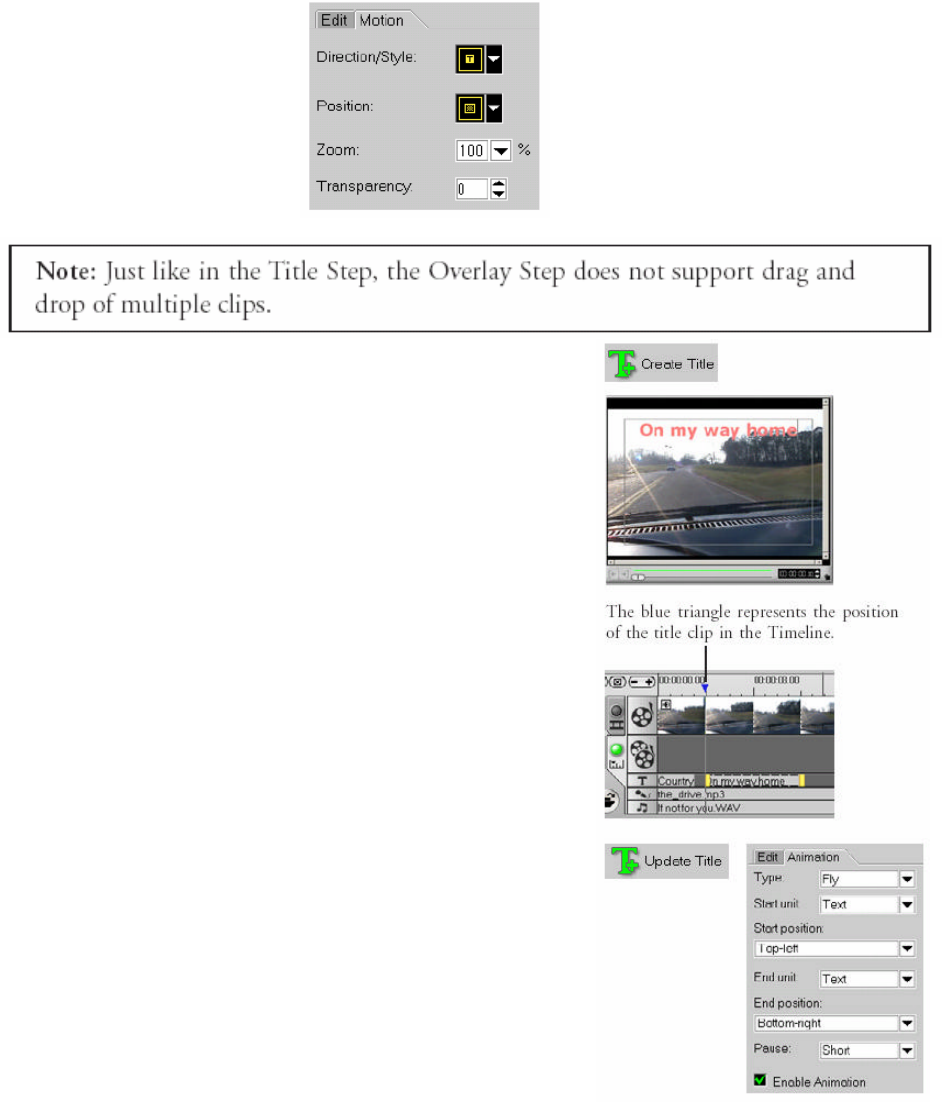
47
2. Click the Motion Tab, and apply a motion style to create a blending effect between the
selected clip and the clip simultaneously running in the Video Track.
Note: Just like in the Title Step, the Overlay Step does not support drag and drop of multiple
clips.
To make Overlay clips with transparent backgrounds, you can create a 32-bit alpha channel AVI
or Image file with an alpha channel. You can further achieve your desired effects by using the
Motion Tab.
Here, you can apply motion styles, set the position of your clip on the screen, magnify or reduce
it, and control its transparency level
5.4 Title
While a picture may be worth a thousand words, the text in your
video production (i.e., subtitles, opening and closing credits, etc.)
adds up to the clarity and comprehensibility of your movie. With
VideoStudio’s Title Step, create professional-looking titles,
complete with special effects, in minutes.
Creating text titles
Titles give the audience an idea of what your movie is all about.
Create eye-catching opening and closing credits, chapter
introductions, scene captions, etc.
To add a text title:
1. Use the buttons in the Navigation Panel to scan your
video and select the frame you want to add a title to.
2. In the Edit Tab in the Options Panel, click Create Title or click
directly in the Preview Window.
Note: When you attempt to create a new title on a frame that
already has
a title clip, it will be inserted after that title clip.
3. Type in your title in the Preview Window and use the style
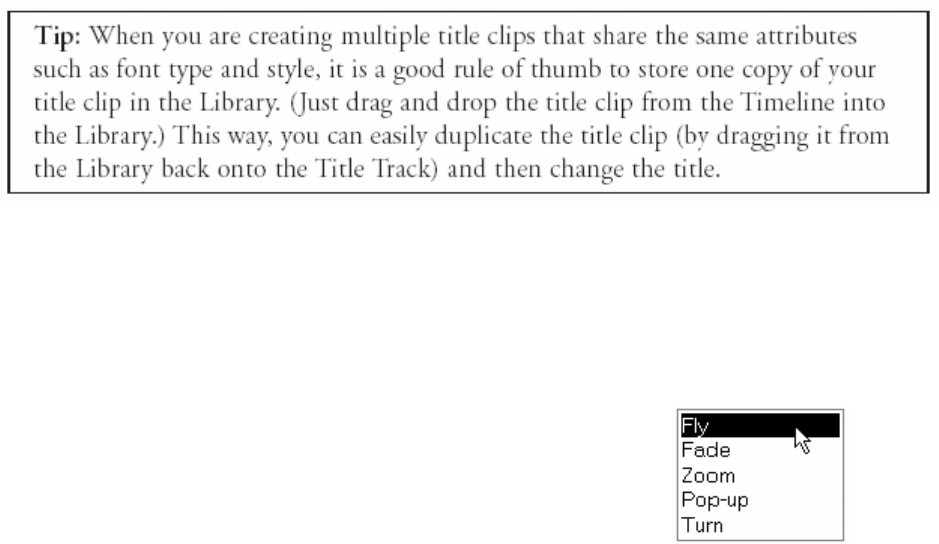
48
buttons to customize fonts. Options are available in the Edit Tab.
4. When you are done typing your text, click Update Title.
5. To add effects to your title, switch to the Animation Tab.
Select an effect from the Type drop-down list, and choose from the available options to animate
the title.
The blue triangle represents the position of the title clip in the Timeline.
When entering a text title, a faint rectangle is visible in the Preview Window. This is the Title
safe area, and it is the recommended maximum size for your text. Along with the rectangle, you
should see a blinking cursor that indicates the starting point for text entry. When entering text,
you can press [Backspace] to correct mistakes and press [Enter] to start a new line. Move
around the text with the arrow keys as needed. To change the attributes of text, first highlight
the text by selecting it with your mouse and then make revisions.
To modify a text title:
• Double-click a title clip in the Title Track. Or,
• Select a title clip in the Title Track and then click on the Preview Window.
5.4.1 Rolling & scrolling
The most commonly used technique for presenting opening or closing credits is by rolling and
scrolling. VideoStudio allows you to do just that. You can even specify the direction and duration
of your scrolling or rolling text.
To scroll a text title:
1. Select a text title in the Timeline or create a new one.
2. On the Animation Tab in the Options Panel, select Fly from the Type
drop-down list.
Tip: When you are creating multiple title clips that share the same attributes such as font type
and style, it is a good rule of thumb to store one copy of your title clip in the Library. (Just drag
and drop the title clip from the Timeline into the Library.) This way, you can easily duplicate the
title clip (by dragging it from the Library back onto the Title Track) and then change the title.
5.4.2 Fading in & out
Another incredibly useful, easy, and effective method of displaying your titles is to fade your text
in from invisible to crisp and clear and then back to invisible again. This works especially well for

49
opening credits with a slow fade, or as captions with a quicker fade.
To create fading titles:
1. Select a text title or create a new one.
2. On the Animation Tab in the Options Panel, select Fade
from the Type drop-down list.
3. Select a fading option. (Crossfade makes the title
gradually appear and then disappear.)
4. Specify a Pause setting (No Pause, Short, Intermediate,
or Long).
5. Specify how to scroll the title by choosing these
animation options:
• Start and End units
Determine whether the whole title (Text) moves, or parts of
the title (Character, Word, or Line) scroll one at a time.
• Start and End positions Determine from what position the
title starts to move in and the final destination where it scrolls
out.
4. Specify a Pause setting (No Pause, Short, Intermediate,
or Long). This makes the title move into the scene, pause for
a moment, and then scroll out of the scene.
5.4.3 Other title animation effects
Give your title more pep by making it pop-up or turn across
the screen. The Pop-up and Turn effects are ideal to use in opening credits.
To apply a pop-up/turn effect:
1. Select a title clip or create a new one.
2. On the Animation Tab in the Options Panel, select Pop up
/ Turn from the Type drop-down list. Make sure that the
Enable Animation option is selected.
3. From the Start unit drop-down list, choose whether to
animate the title on a Text, Word, Line, or Character basis.
4. Choose a Start position where you want the title to enter
the
screen. If you applied the Turn effect, also choose an End
position where you want the title to exit the screen.
5. Click Play to preview.
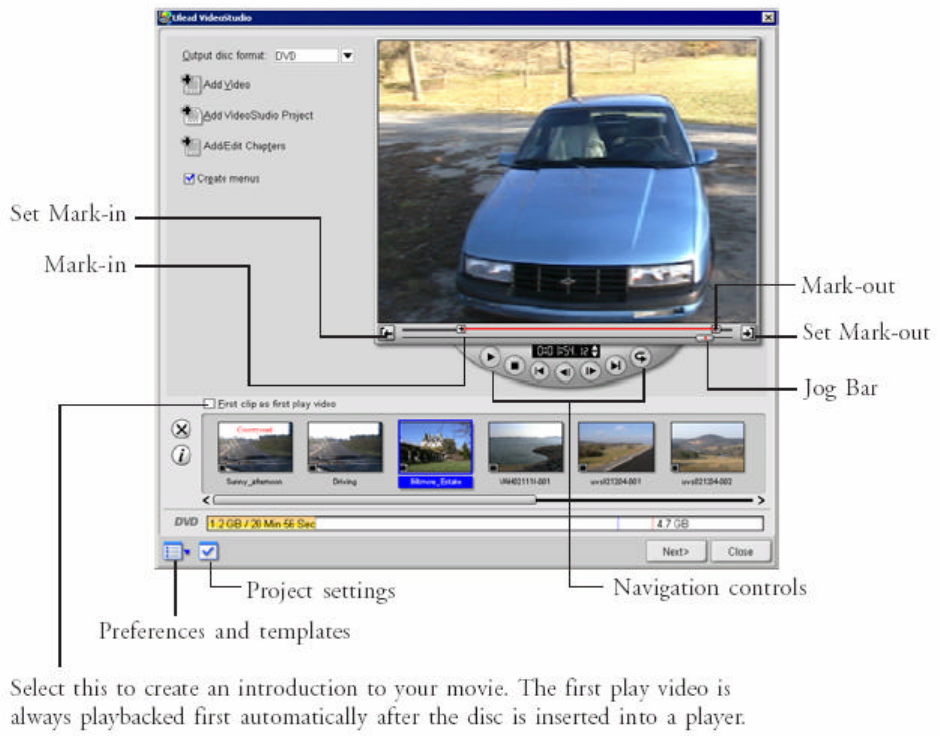
50
5.5 Creating disc
This is the place where you can output your project (together with other VideoStudio projects or
video as needed) to create VCD, SVCD, or DVD. First, choose an output format. Second,
decide whether you want to add other projects and videos. See the following sections for more
information.
To add videos:
1. Click Add Video.
2. Locate the folder where the videos are, and then select one or more video clips you want to
add.
3. Click Open.
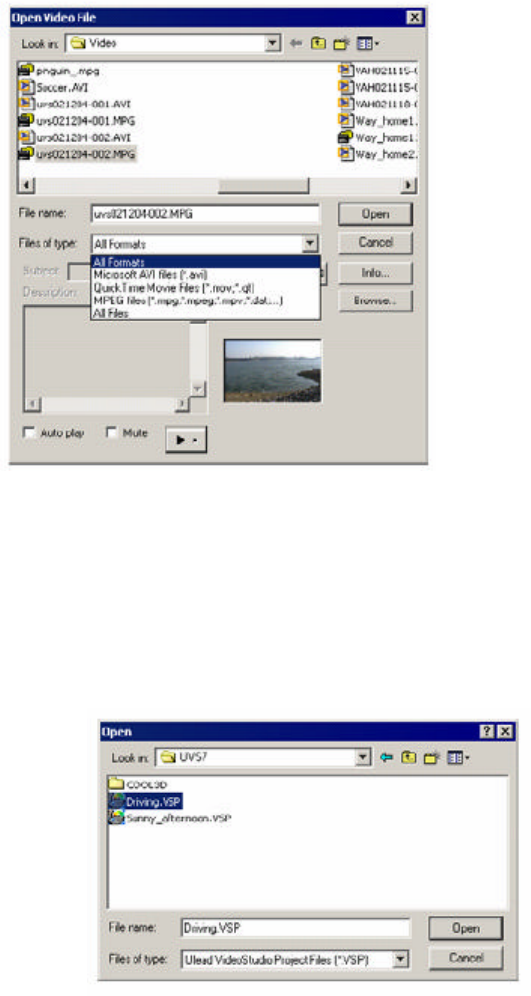
51
Notes:
• You can add video formats such as AVI, QuickTime, and MPEG files. You can also add VCD
video (DAT) files.
• After a video clip is added to the Media clip list, sometimes you may see a black thumbnail.
This is because the first scene (frame) of this video clip is a black screen. To change it, double-
click to select this video clip and move the Jog Bar to the scene you want. Next, right-click the
thumbnail and select Change Thumbnail.
To add VideoStudio projects:
1. Click Add VideoStudio Project.
2. Locate the folder where the projects are, and then select one or more video projects you want
to add.
3. Click Open.
Preferences
You can press [F6] to open this dialog box with the following three options:
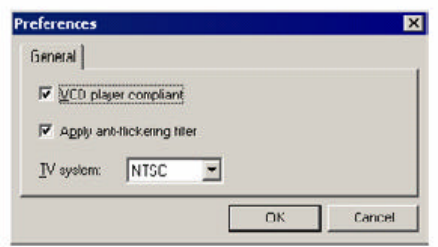
52
• VCD player compliant Ulead VideoStudio uses the VCD 2.0 format when creating VCDs. For
navigation menus with background
music, Ulead VideoStudio uses a format that requires "variable-bit-rate (VBR)" decoding.
However, some VCD players do not support VBR
decoding and therefore VCDs created in Ulead VideoStudio will not play correctly in these
players. Select this option to make sure that the VCD created will play in these players.
• Apply anti-flickering filter Select to apply the anti-flickering filter to the menu pages. The anti-
flickering filter reduces the "flickering" that happens when using a television (interlaced display)
to view the menu pages. However, this does not help when the menu page is viewed on
progressive scan devices such as computer monitors or projectors.
• TV system Select the type of your TV system (NTSC or PAL).
Trimming a video
You can trim a video using the Jog Bar, mark-in/out, and navigation controls. (See the
illustration below.) Trimming a video gives you the freedom to precisely edit the video length.
Adding/editing chapters
This feature is only available when the Create menus option is selected. By doing so, you can
create submenus linked to their associated video clip at the setup menu step later.
Represented as a video thumbnail in a submenu, each chapter is like a bookmark for a video
clip. Viewers can easily select a chapter then the video clip will immediately jump to the first
scene of that chapter and start the playback. This feature is particularly useful when you want to
attract your viewers by giving them the freedom
to choose a particular part of the movie to watch. Note that these small video thumbnails only
link to its “mother” video without generating any additional physical video files. So, you don’t
need to worry about the possibility of unexpected file size increase.
Notes:
• You can create up to 99 chapters for a video clip.
• If the Create menus option is not selected, you will be guided to the preview step immediately
without creating any menus after clicking Next.
• When you are creating a disc with only one VideoStudio project or one video clip, do not select
First clip as first play video if you want to create menus.
Project settings
Use this for advanced MPEG output settings:
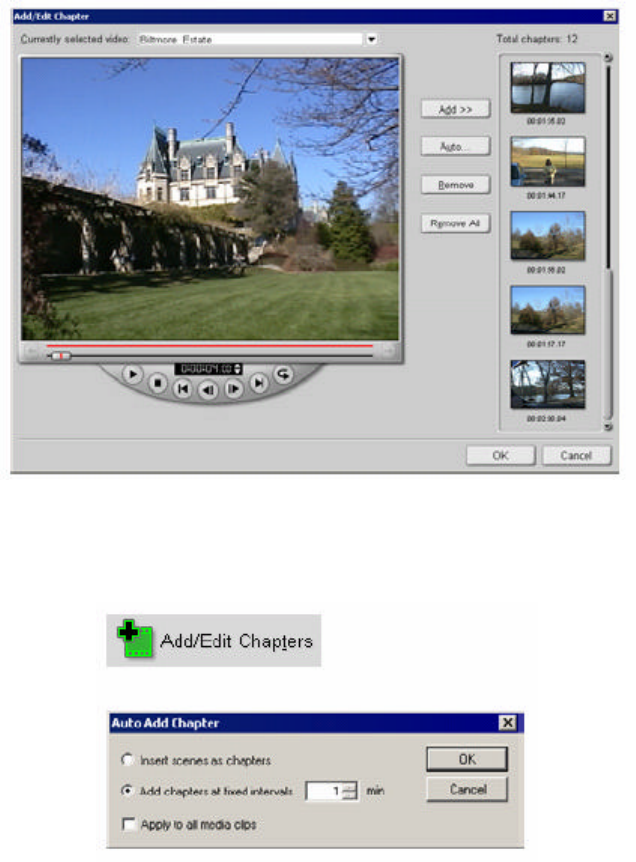
53
• MPEG properties for file conversion
Displays detailed information about the selected video setting.
• Change MPEG Settings Select the type of video setting of your project. Select Customize to
personalize video settings.
• Do not convert compliant MPEG files Select to retain settings of every MPEG compliant file.
• Auto repeat when playback ends Select to automatically replay the video every after playback.
To create or edit chapters linked to a video clip:
1. Select a video in the Media clip list.
2. Click Add/Edit Chapters.
3. Click Auto to let Ulead VideoStudio help you select chapters (such as at fixed intervals), or
drag the Jog Bar to
move to a scene as the first frame of a chapter, and then click Add.
Tips:
• If you want to use Auto, your video must be at least one minute long or the video has scene
change information.
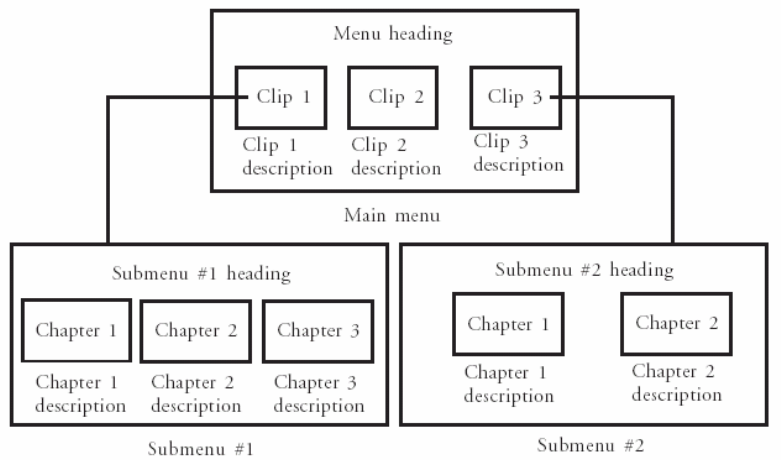
54
• If you click Auto and your video is a DV-formatted AVI file captured from a DV camcorder,
Ulead VideoStudio can automatically detect scene changes and add chapters accordingly.
• If the selected video is an MPEG-2 file with scene change information, Ulead VideoStudio
automatically generates these chapters for you when you click Auto.
4. Repeat Step 3 as needed. You can also use Remove or Remove All to delete unwanted
chapters.
5. Click OK.
Setup menus
At this step, you can create the main menu and submenus. They provide a list of interactive
thumbnail-styled options displayed on a screen for your movie viewer to choose from. Ulead
VideoStudio includes a set of menu templates to best fit the purpose of each menu.
To help you better understand the DVD/SVCD/VCD menu structure, see the illustration below.
In this example, Clip 1 has three chapters so when you click the Clip 1 video thumbnail, it will
jump to submenu #1. If you look at Clip 2, it has no chapters assigned to it therefore there is no
To edit menus:
1. By default, Ulead VideoStudio automatically makes all required menus for you. Use Currently
displayed menu to switch to the menu you want to edit.
2. Click “My Title” to customize the menu heading. You can also click the text description under
each video thumbnail for customization.
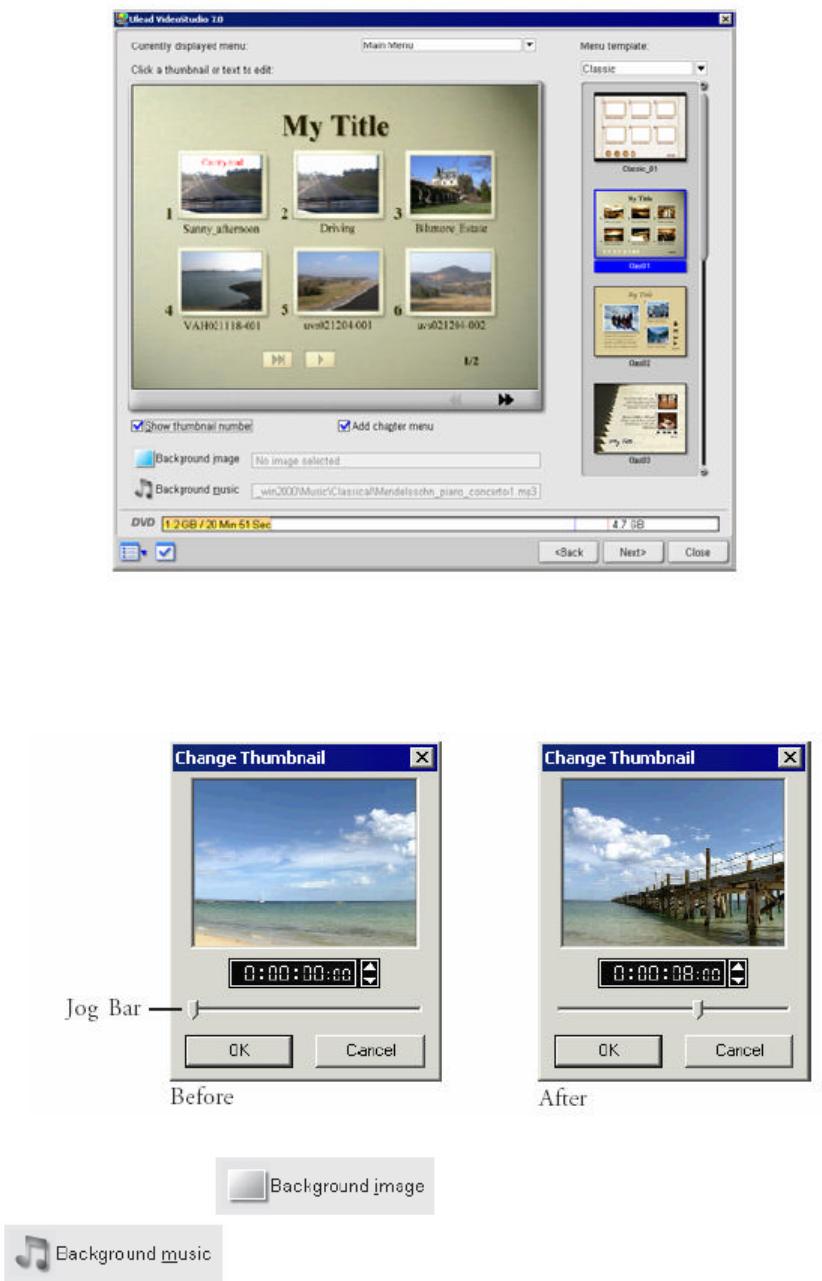
55
3. To change the image shown on each video thumbnail, click it then drag the Jog Bar to
change.
Note: If you skip Step 2, “My Title” and the thumbnail name will be used as the menu heading
and the text description respectively. If you don’t want to show the menu heading or the text
description, simply delete it.
4. To change a menu layout, use the Menu template list and select another preset.
5. You can also click to use your own background image, or click
to use your background music.
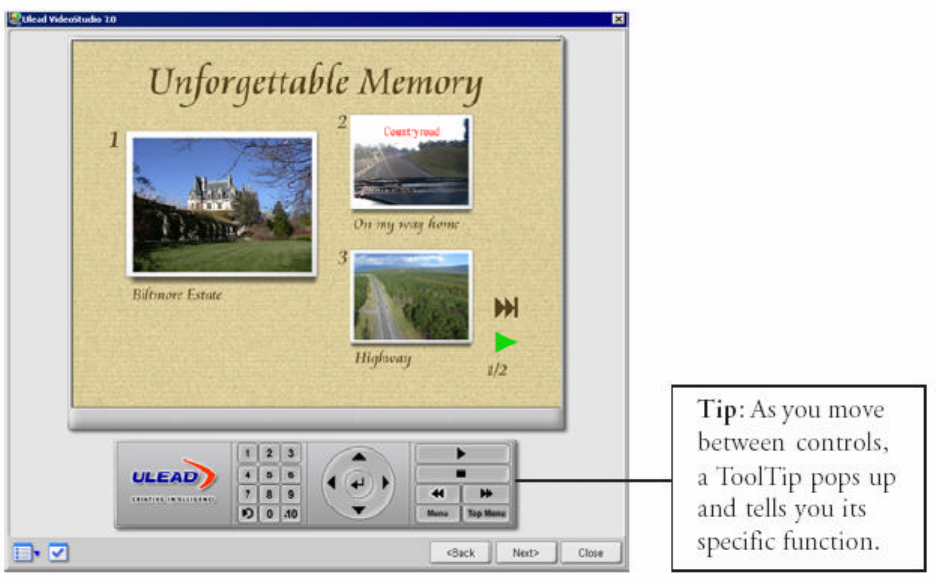
56
6. When you’re done, click Next to preview the movie.
Preview your movie
Now, it’s time to see how your movie looks like before you burn it onto a disc. Simply move the
mouse and click Play to watch your movie and test the menu selection on your computer. Use
the navigation controls here as you would on a standard remote control of a home DVD player.
Output your movie
This is the final step before your video disc or output file is ready.
Here, you can choose the disc burner, as well as select the folder where you want to output
video files or a disc image file.
Tip : Before actual disc burning starts, make sure the disc in the correct format has already
inserted into the disc burner.
To output your movie:
1. Enter a volume name (up to 32 characters) for the output disc.
2. In Output settings, select one or more tasks you want to do. For example, select the
recording format that best suits your need. (See the notes on the next page). You can also click
Output Advanced Settings if you want to add additional components such as a video disc player
or your personal data.
Tip : As you move between controls, a ToolTip pops up and tells you its specific function.
3. Select a disc burner and make settings (such as the recording speed) compatible with your
output disc format.
4. Click Output.
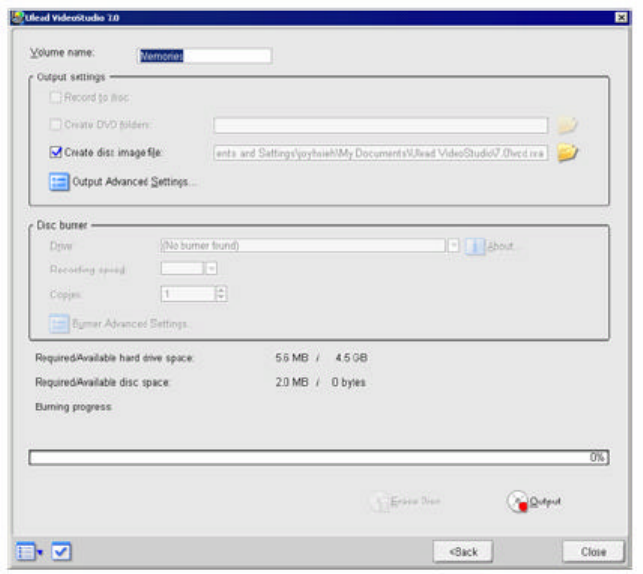
57
5. The burning progress bar shows you the burning status. Once it is done, click Close.
Notes on how to choose an appropriate recording format:
• Ulead VideoStudio provides an option, DVD-Video (fast editable), that allows you to still use
the industrial standard DVD-Video format, however, it will only burn the necessary files you
need so you can edit your video content (e.g. menus) in the future. This option saves time in
copying files and hard drive space when you edit the contents of your disc again but may result
in your disc not being compatible with some DVD players.
• If DVD-Video (fast editable) is selected, options in the Output Advanced Settings dialog box
such as Include personal folder to disc will not be available.
• If DVD-Video (fast editable) is selected, keep in mind that there is a 30MB file size limitation
for menus, background audio and project file combined. Audio files have larger file sizes and
therefore it takes up the bulk of this file size limitation. Reduce the file size of your audio (e.g.
shorter length) if you plan to have a lot of menus.
• If you choose DVD-Video, you will be using the industrial standard DVDVideo format for
maximum compatibility. However, you cannot enjoy the advantages brought by the DVD-Video
(fast editable) option.

58
6 FusionMPEG2 APPENDIX
6.1 TROUBLESHOOTING
Symptom: Jerky screen.
Solution:
1. Slower CPU
If you’re using slower than 500 Mhz CPU, you can change the recording
resolution size to 480x480 or 352x480 to get the more natural screen.
2. Main board chip set and VGA driver.
A lot of bugs and errors are reported when using VIA 693x chipsets with most of
the multimedia cards. It requires the VIA’s latest patches. If you’re using the VIA
69x chipset, please visit the VIA’s WEB page and download the latest VIA patch
driver, then apply it. Or you can visit the Dvico’s home page (www.dvico.com)
which provides the appropriate links to VIA.
3. Sound card driver.
You should download the latest sound card driver on each sound card company, if you experience the jerky
screen even with faster CPU.
4. Fragmented HDD
If you’re installing the Windows long time ago, it’s mostly likely that the HDD is
fragmented. Please run the Windows de-fragmentation utility.
Symptom: ‘MPEG2 decoder not found’ error
Solution:
1. WinDVD was not installed
Please make sure that you installed the WinDVD. Please uninstall, and then re-
install the FusionMPEG2 setup. In setup procedure, do not skip the WinDVD
setup.
2. Other APP is using the MPEG2 decoder.
Close the other APP that uses the MPEG2 decoder. (like MediaPlayer or
something.)
Symptom: ‘MPEG2 rendering failed’ error
Solution:
Close the other APP that uses the MPEG2 decoder (like MediaPlayer or some
other APP.) and sound card. If other APP uses the sound card, FusionMPEG2
fails to locate the sound output, so it shows this error.
Symptom: ‘Time-shift filter error’ appears.
Solution:
Reboot the computer in FusionMPEG2 PCI. You’ll get this message when
terminates the FusionMPEG2 APP abnormally. Please press the RESET button
on FusionMPEG2 USB and re-run the FusionMPEG2 APP.
It’s typical hardware error. Please re-install the hardware to other slot, or clean
the PCI slot edge of the PCI card, if you experience the problem even in first
booting.
Symptom: Video does not show on Windows 2000.
Solution:
Visit the web site of your VGA card company and download the latest driver of
Windows 2000. Since most of VGA companies’ priority is Win’98/ME, Win2000
drivers were updated late. If you does not experience this symptom in Win’98,
it’s most likely the Win2000 VGA driver problem.

59
Symptom: Shows blue screen on Windows 2000.
Solution:
It requires the VIA’s latest patches. If you’re using the VIA 69x chipset, please
visit the VIA’s WEB page and download the latest VIA patch driver, then apply it.
Or you can visit the Dvico’s home page (www.dvico.com) which provides the
appropriate links to VIA.
Symptom: FusionMPEG2 does not work in Windows 2000 Advanced Server.
Solution:
Because of enforcement of securities, Windows 2000 Advanced Server sets a
lot of limitation regarding to registry. FusionMPEG2 only runs on Windows 2000
professional when it comes to W2K.
Symptom: ‘Sound card already used by another APP’ error appears.
Solution:
Symptom: ‘Sound card not found’ error appears.
Solution:
Close the other APP that uses the sound card (like MediaPlayer, RealPlayer,
MP3 player) If other APP uses the sound card, FusionMPEG2 fails to locate the
sound output, so it shows this error.
Symptom: Sound is recorded with echoes.
Solution:
It’s because of sharing the same IRQ number with FusionMPEG2 and sound card. Please
move the FusionMPEG2 to other slot or re-route the IRQ sharing to avoid the same IRQ
number with sound card.

60
6.2 SPECIFICATIONS
FusionMPEG2 Specification
Item Specifications Comment
Features l Real time MPEG1/MPEG2/VCD/SVCD/DVD encoder
l Using the superb Conexant CX23416 MPEG2 chipset
l Up to 15Mbps MPEG2 encoding bitrate
l USB 2.0 Interface
l USB bus-powered – no DC adapter required
l Audio input gain controllable
l Ultra slim and cute design
l Super fast SVCD/ VCD/ DVD creation
l Guarantee the perfect AV sync at all modes
l Using the Dvico’s native MPEG2 software decoder
l Incredible cut-on-the-fly feature
l Support time-shifting function (pause, fast forward, fast
backward, position skip)
l No 4G recording limit – generate indexed files.
l
Selecting capturing quality of high, middle, VCD/
SVCD/ DVD/ Optional MPEG1/ Optional MPEG2
l Support NTSC and PAL input
Input/Output l One composite and one S-VHS input
l One stereo RCA input for audio
Compatibility
(System)
l Pentium-500MHz with 128M memory (minimum)
l Runs on Win’98SE / ME/ 2000/ XP
l Ultra-DMA33 enabled mother board and HDD
l Requires one USB 2.0 or 1.1 port
l Requires PCI sound card for playback
Compatibility
(Video &
Sound)
• Frame rate – NTSC 29.97Hz, PAL 25Hz
• Color depth – 24bit
• Spatial resolution –
MPEG1/2: 720x480,480x480,352x480,352x240 (NTSC)
720x576, 480x576, 352x576,352x288 (PAL)
• Video bitrate - 2~12 Mbps(MPEG2), 1~4 Mbps(MPEG1)
• Audio bitrate – 192, 224, 384 Kbps
• Audio sampling rate – 32/44.1/48KHz
Drivers l Dvico’s native WDM driver
l Dvico’s native time delay filter
l Dvico’s native MPEG2 decoder filter
Application
Software
l Dvico’s FusionMPEG2 Application for PVR application
l Dvico’s MPEG2 software video/audio decoder
l Ulead DVD MovieFactory2 for DVD authoring / burning

61
6.3 CUSTOMER SUPPORT
Please contact below address or WEB, if you have further questions or problems.
WEB : http://www.dvico.com
EMAIL : cs@dvico.com
TEL : +82-31-728-1394
FAX : +82-31-717-8980
ADDRESS :
463-810
Dvico, Onse Telecom B/D 4F, Goomi 192-2, Boondangku, Sungnam City, Kyongki-do, South
Korea
